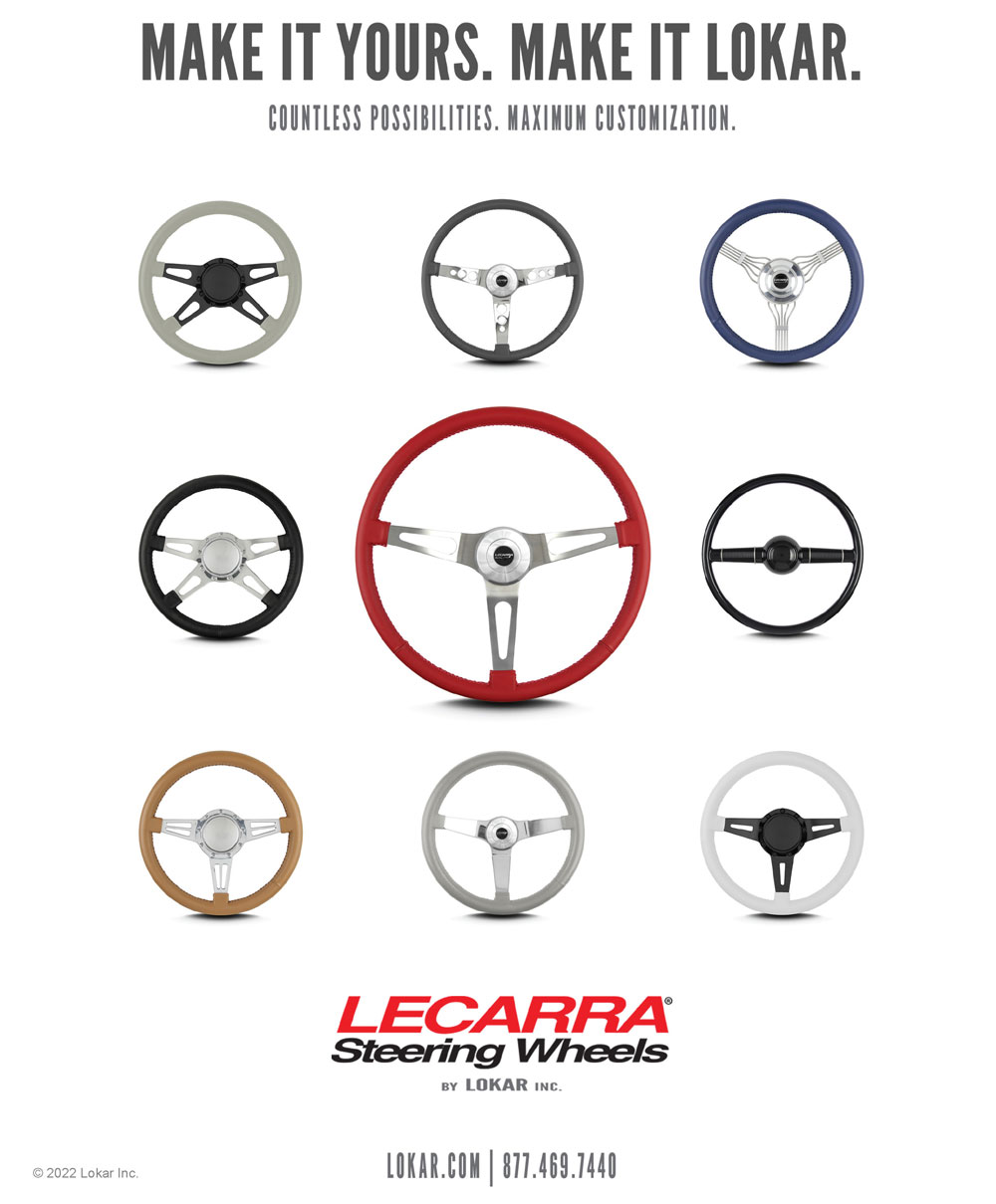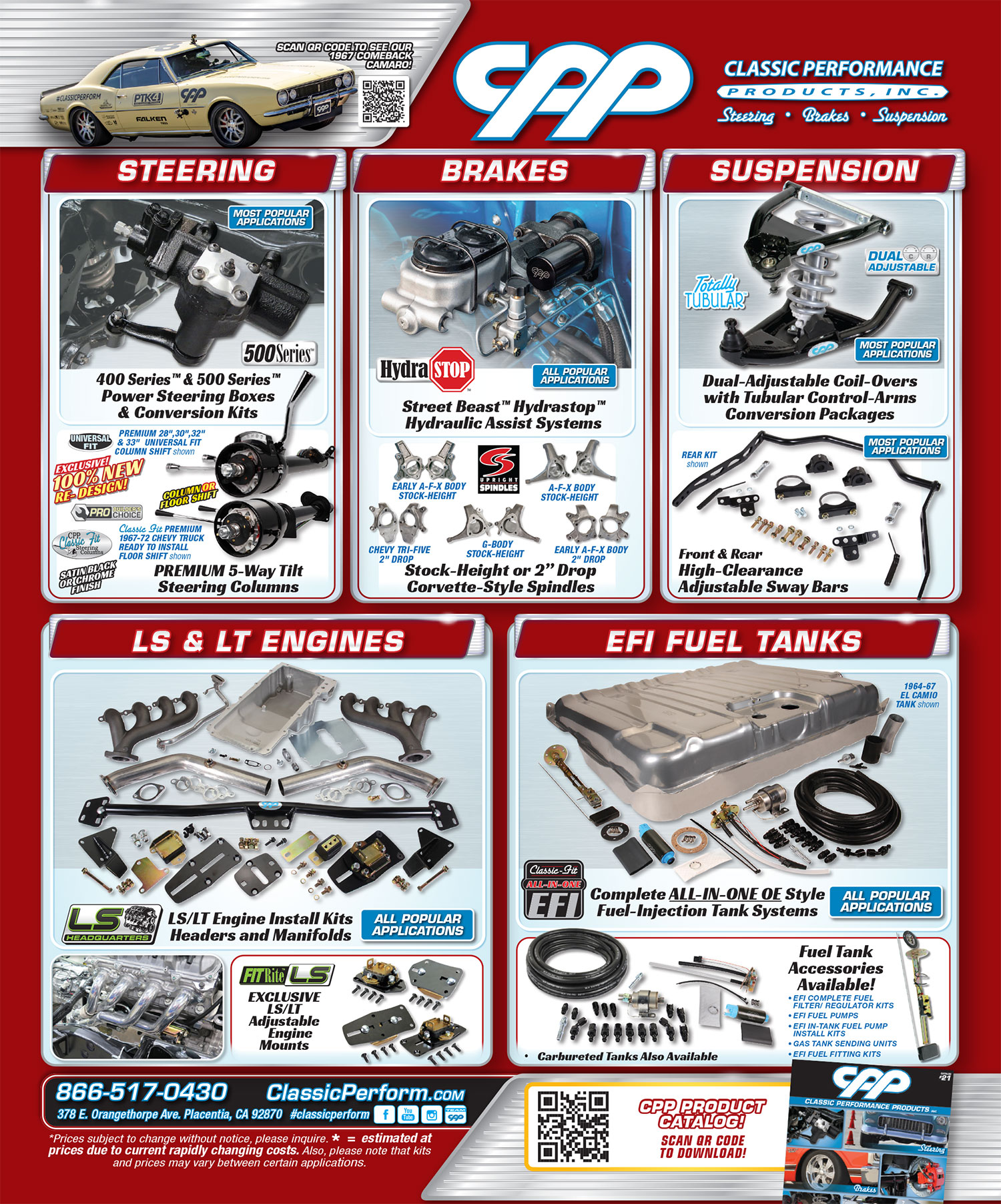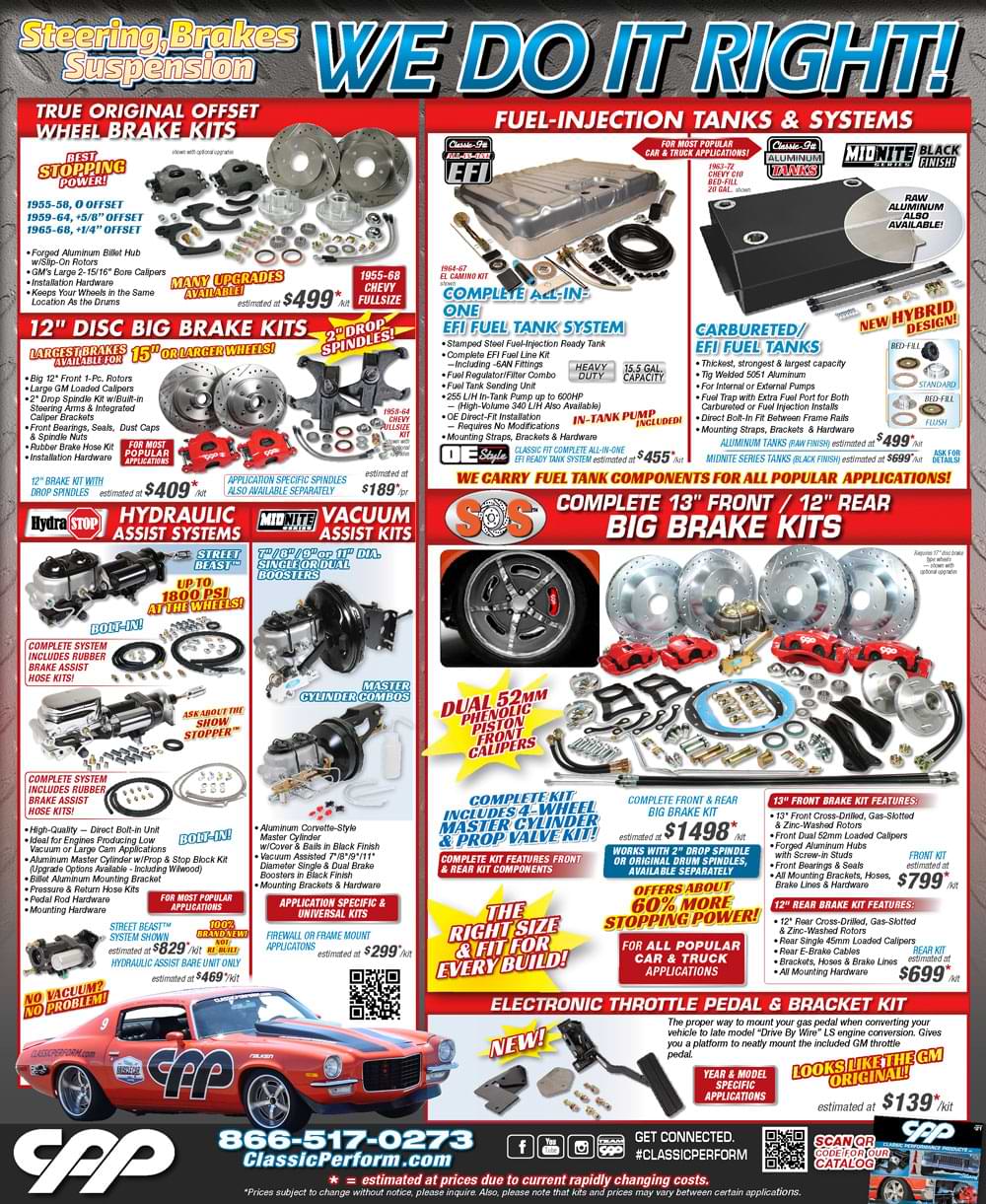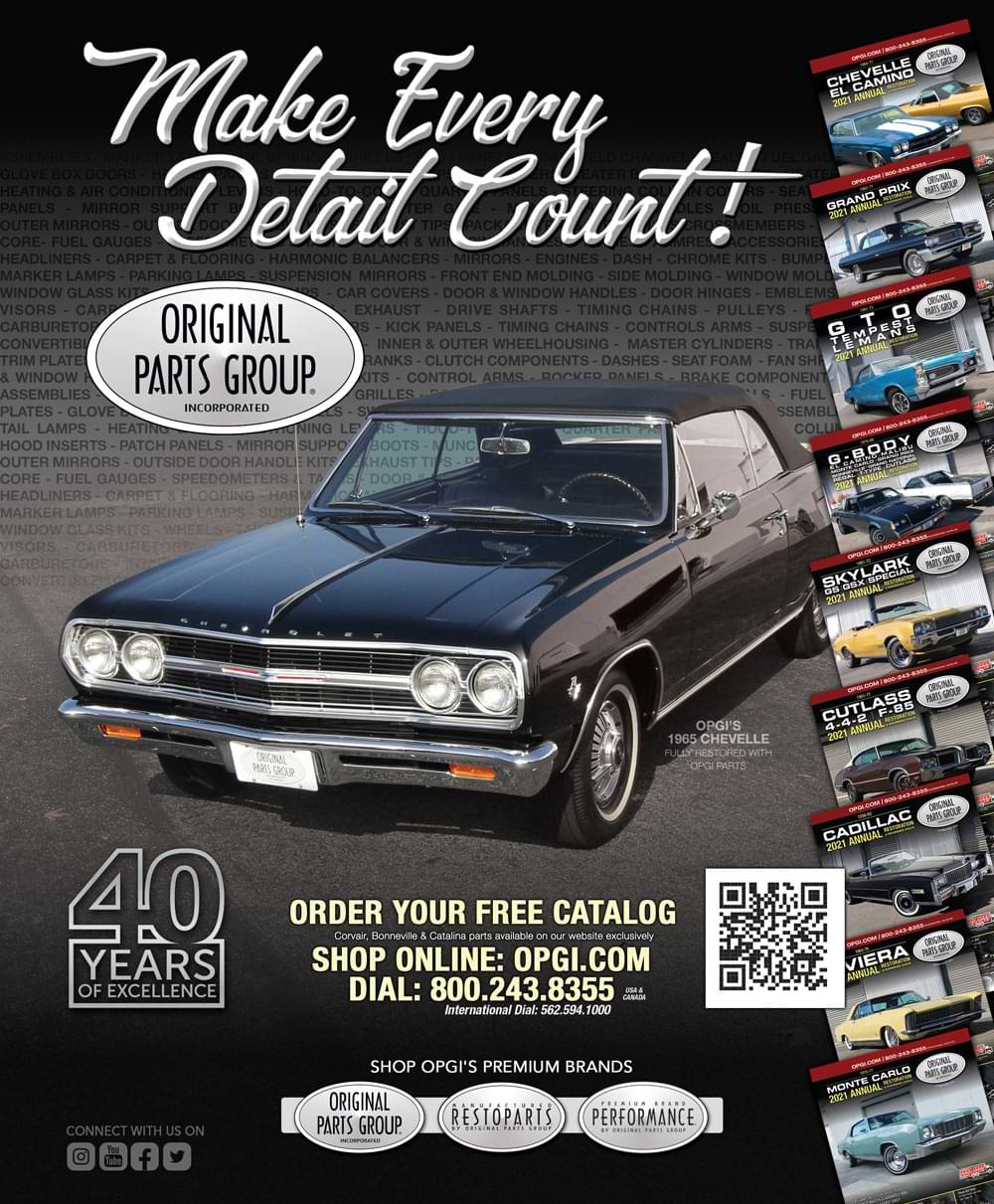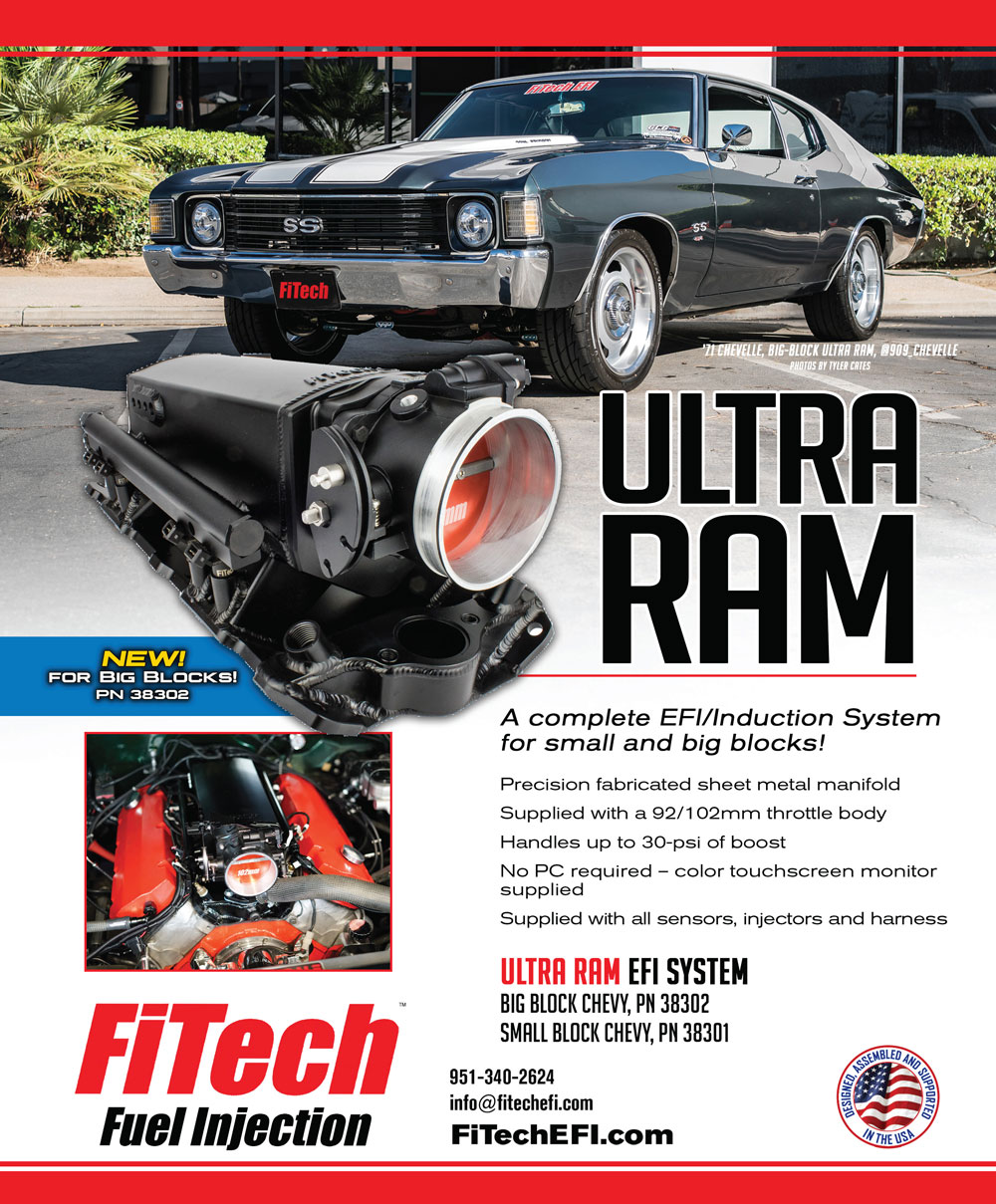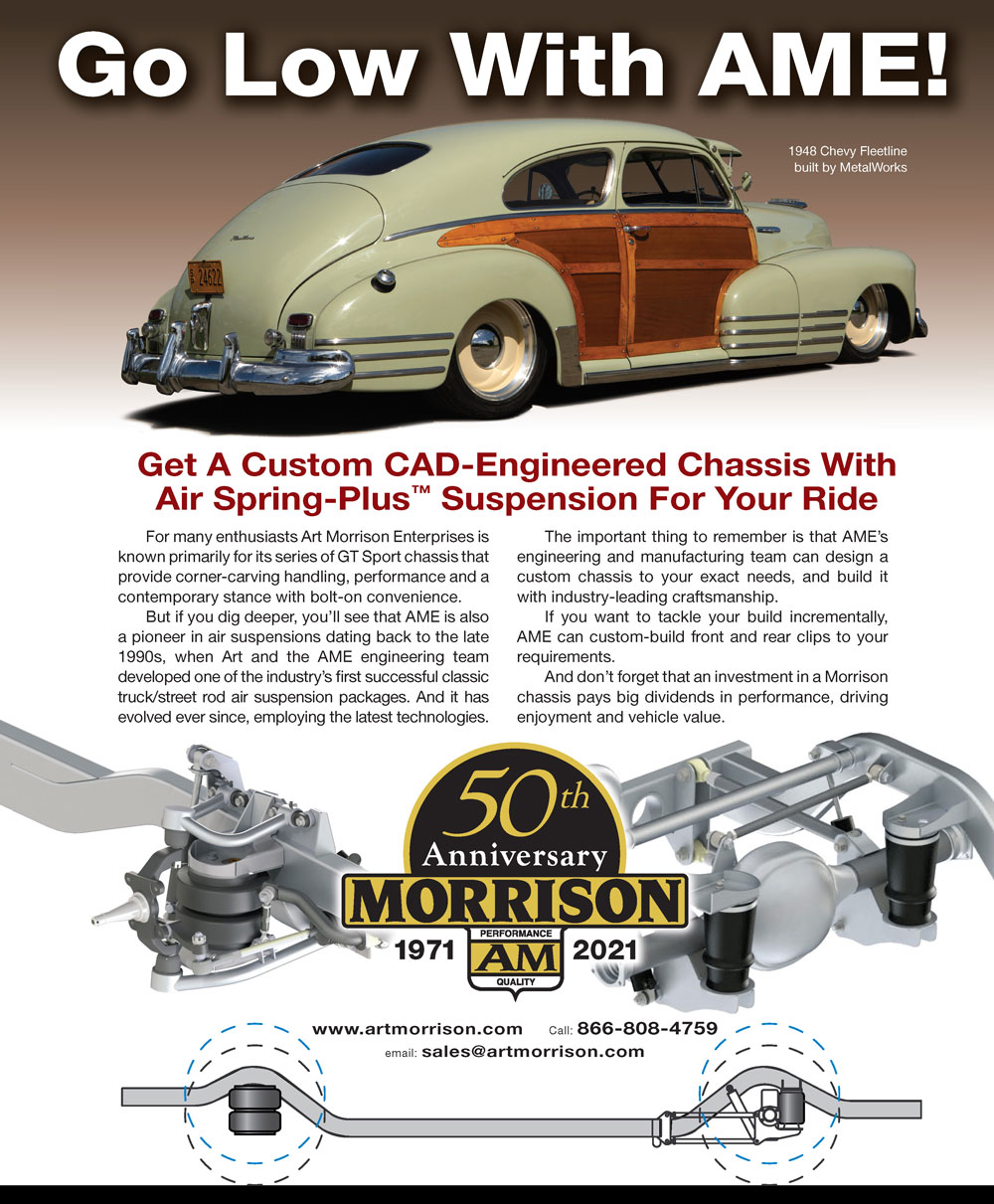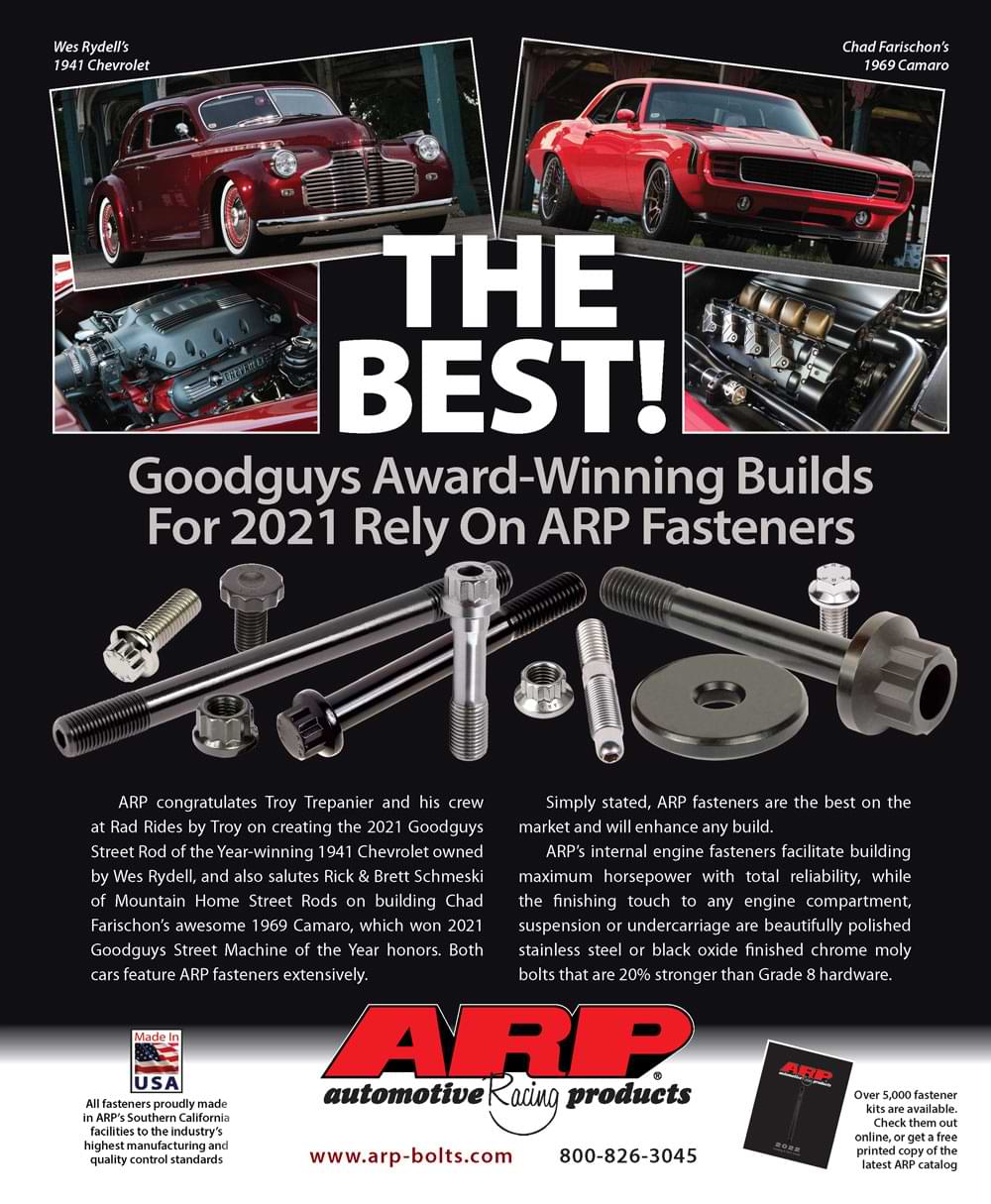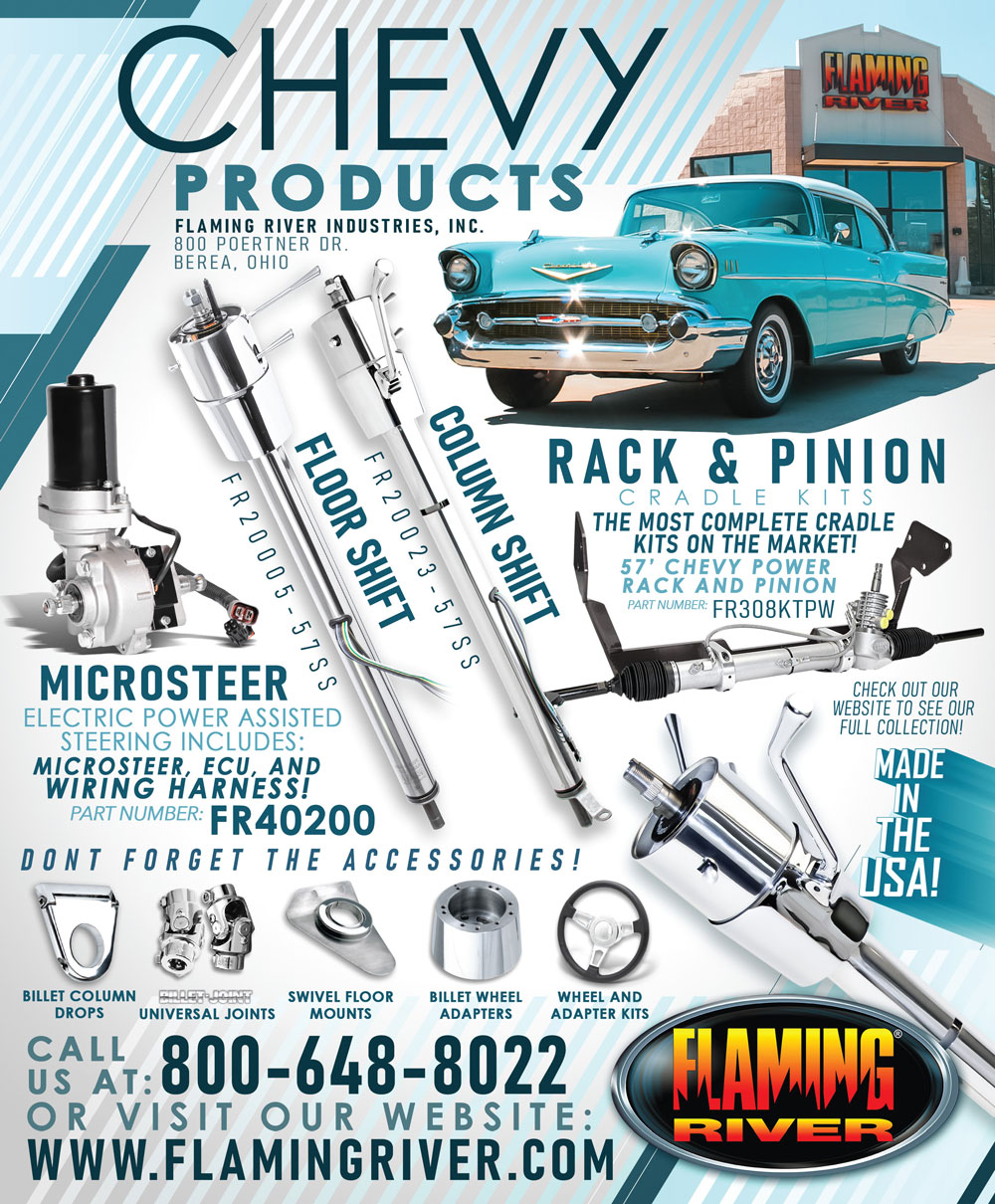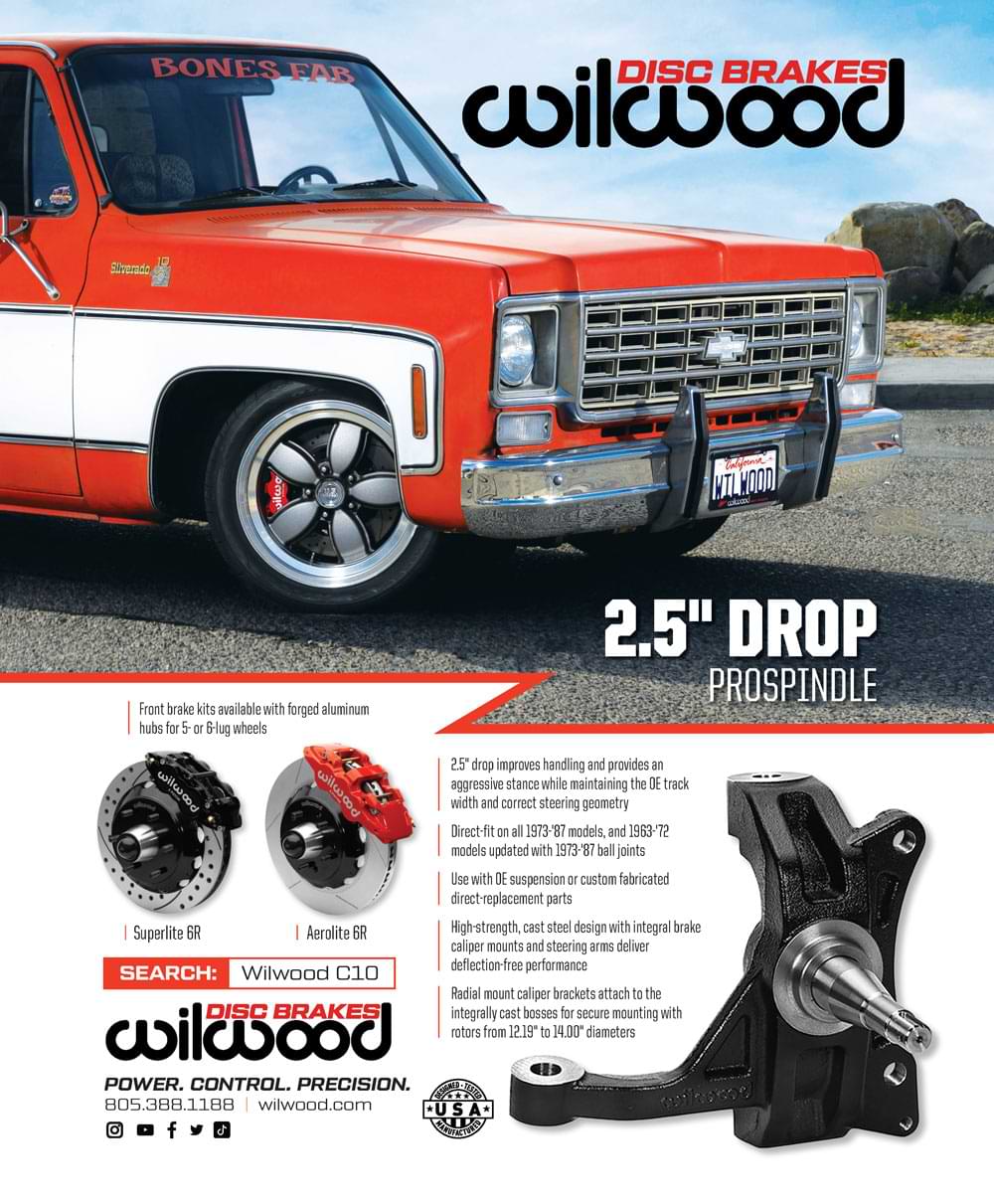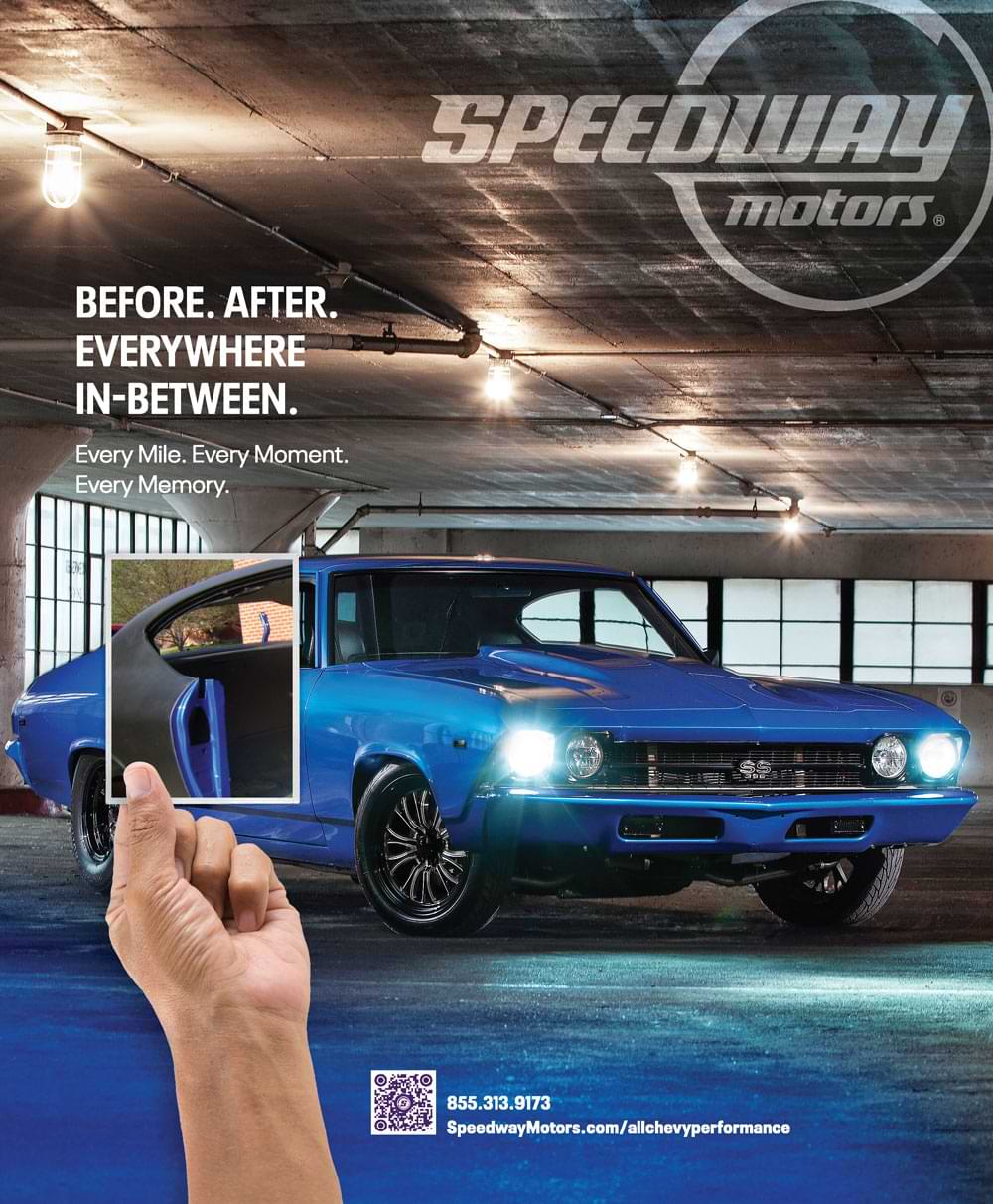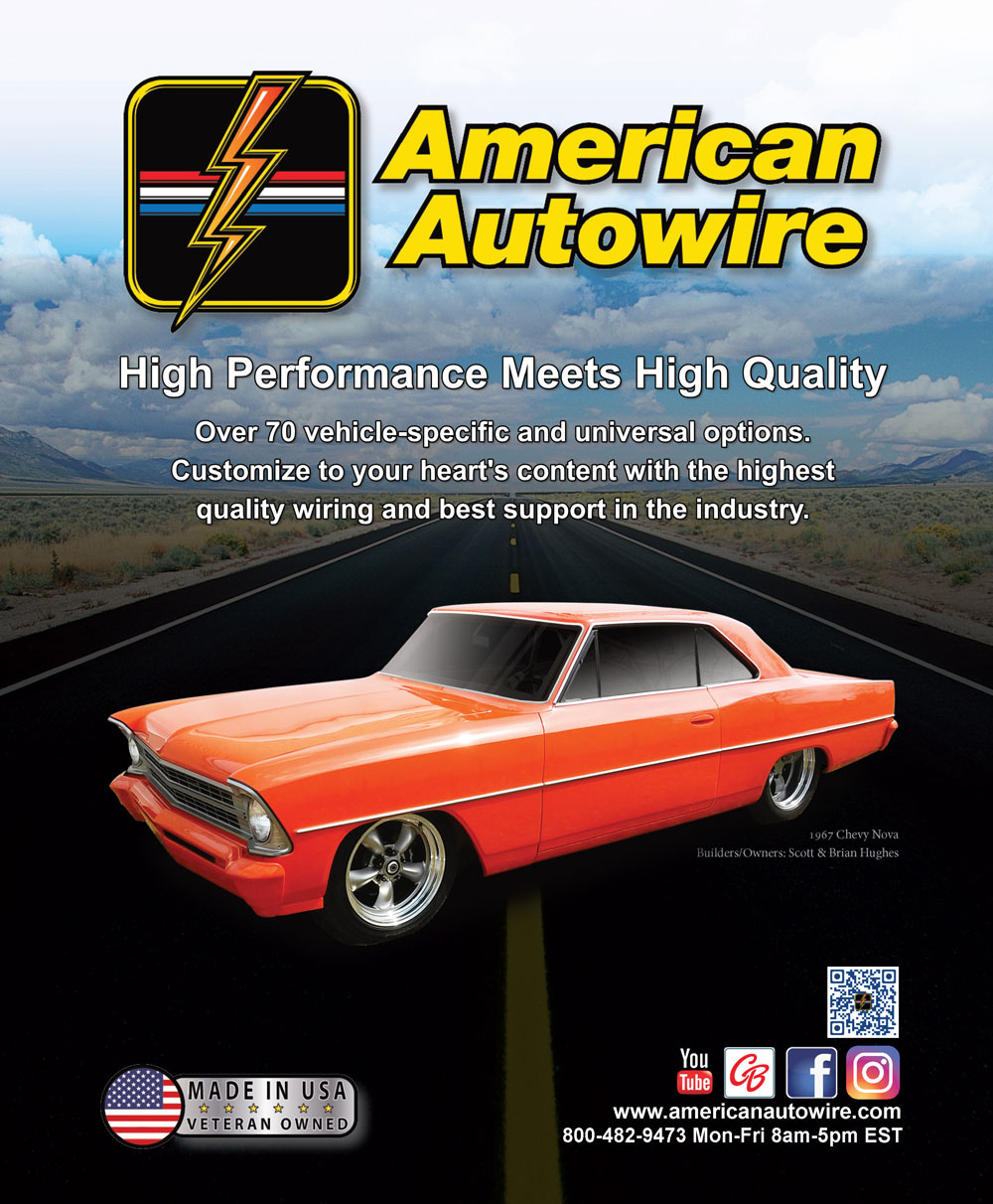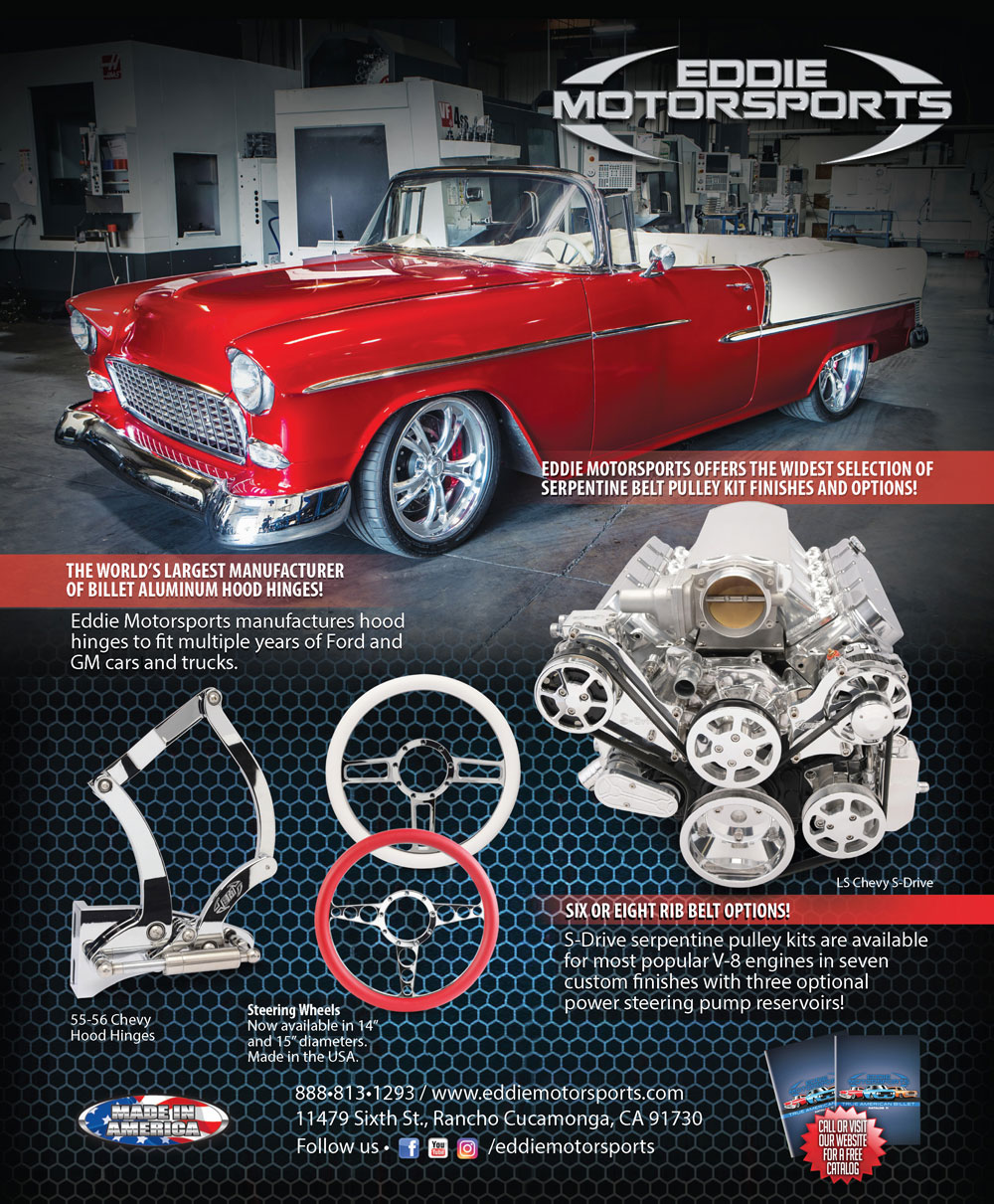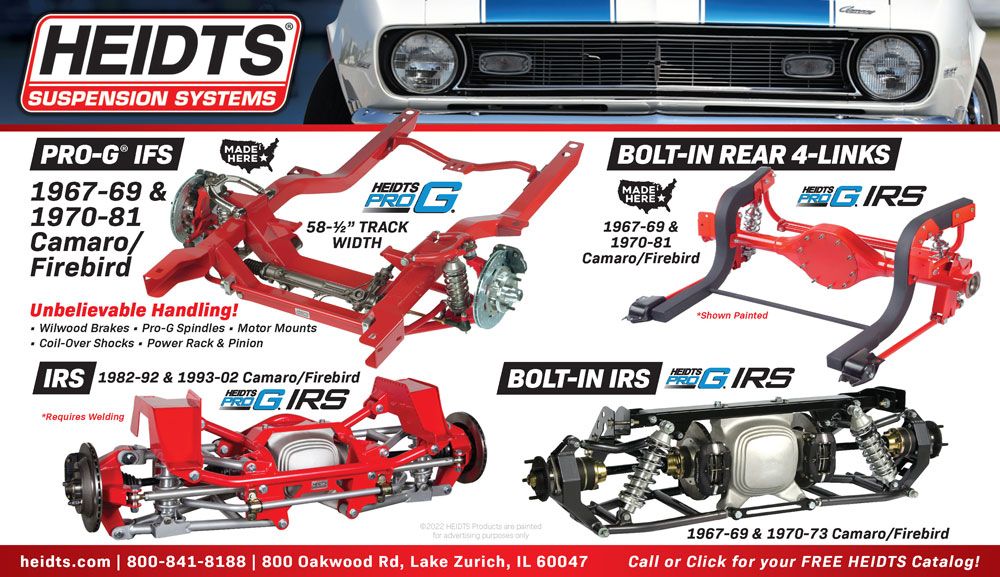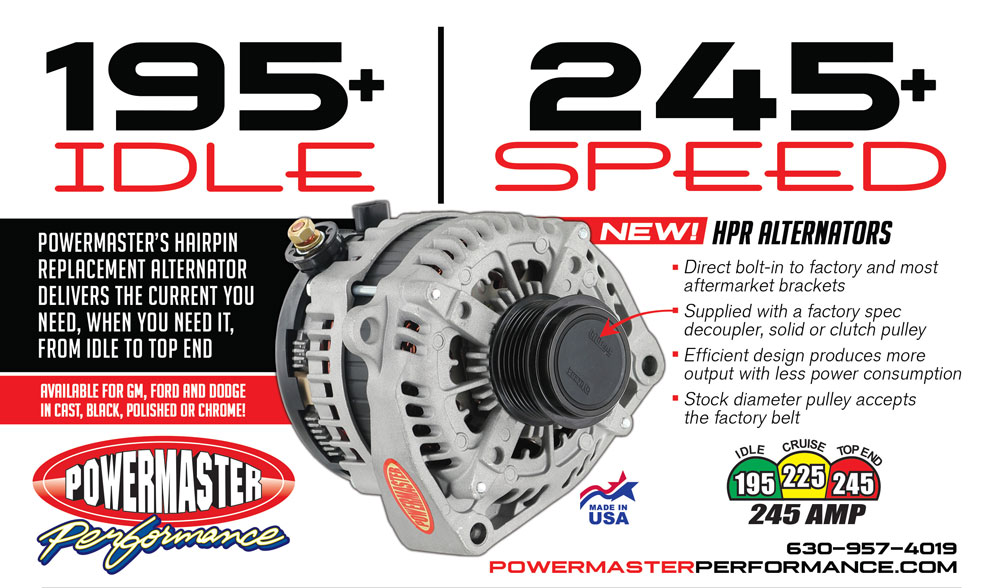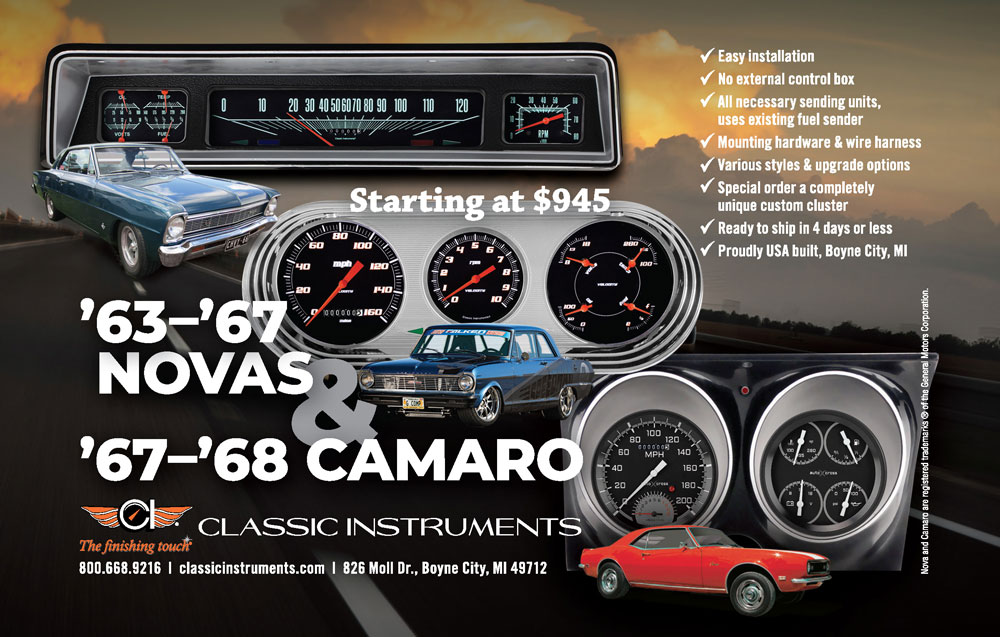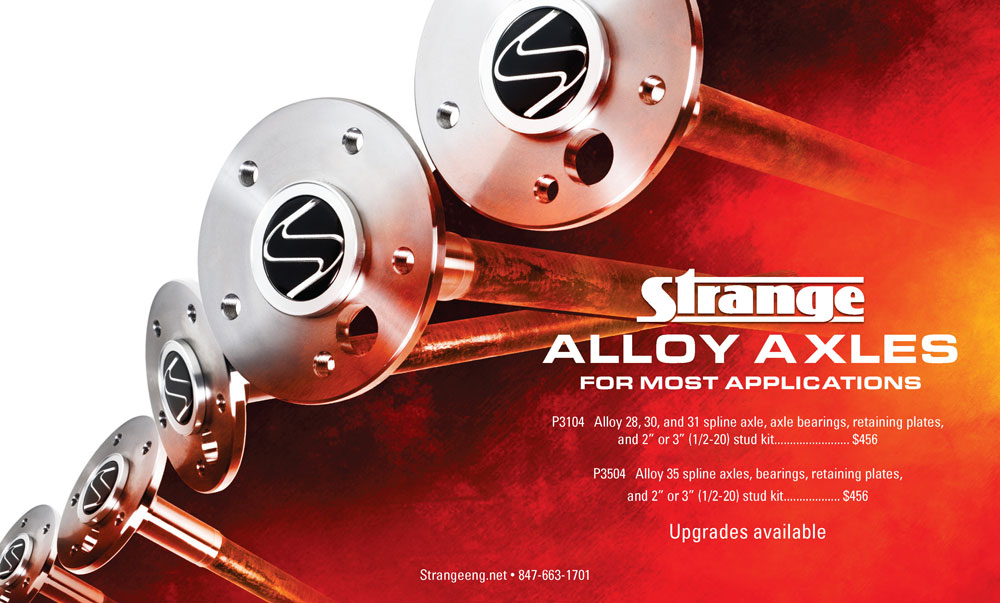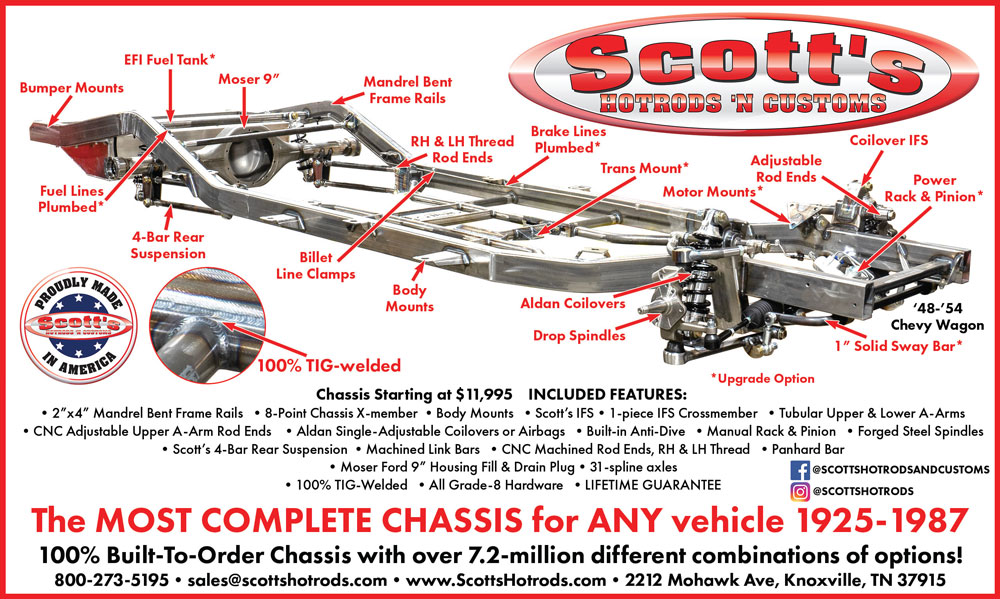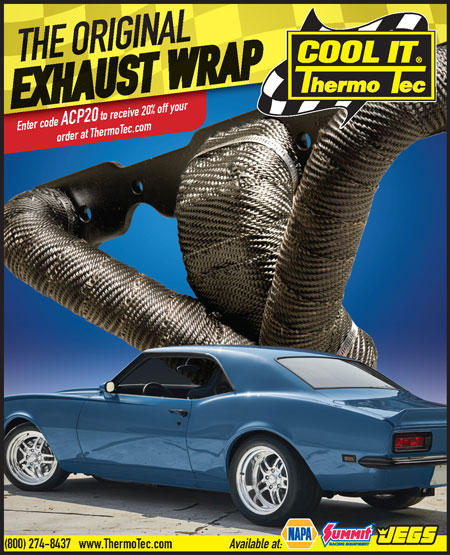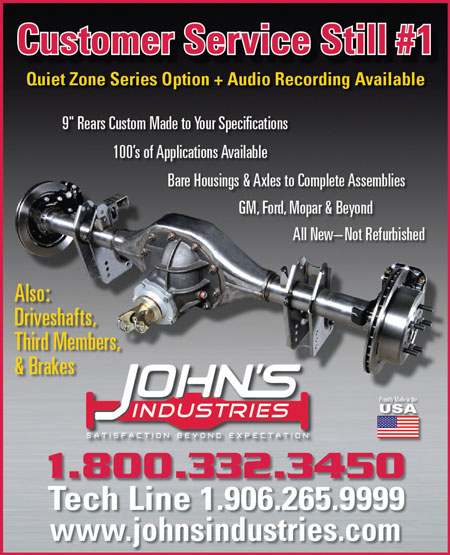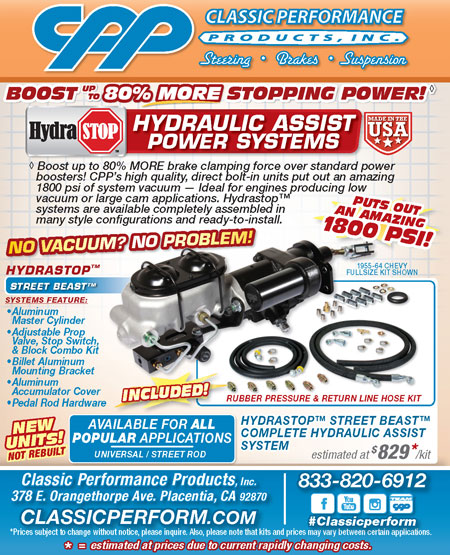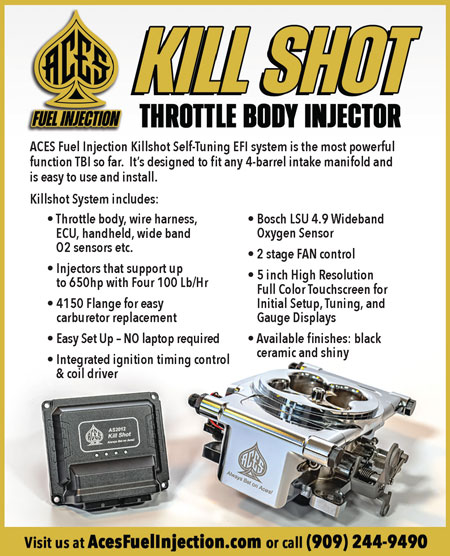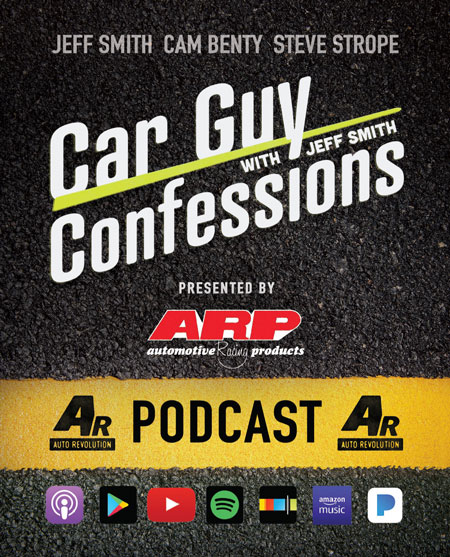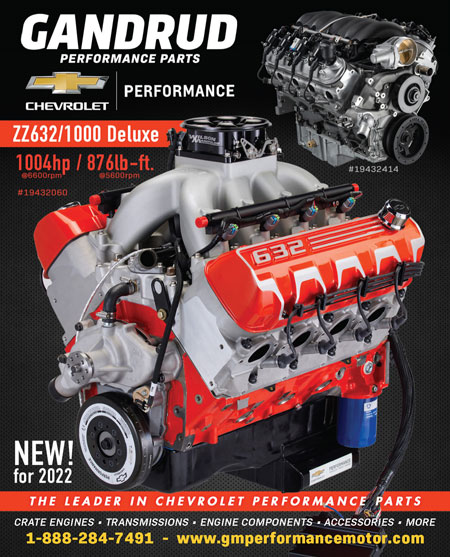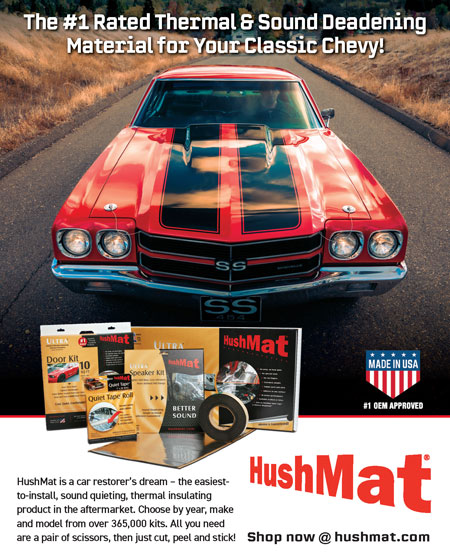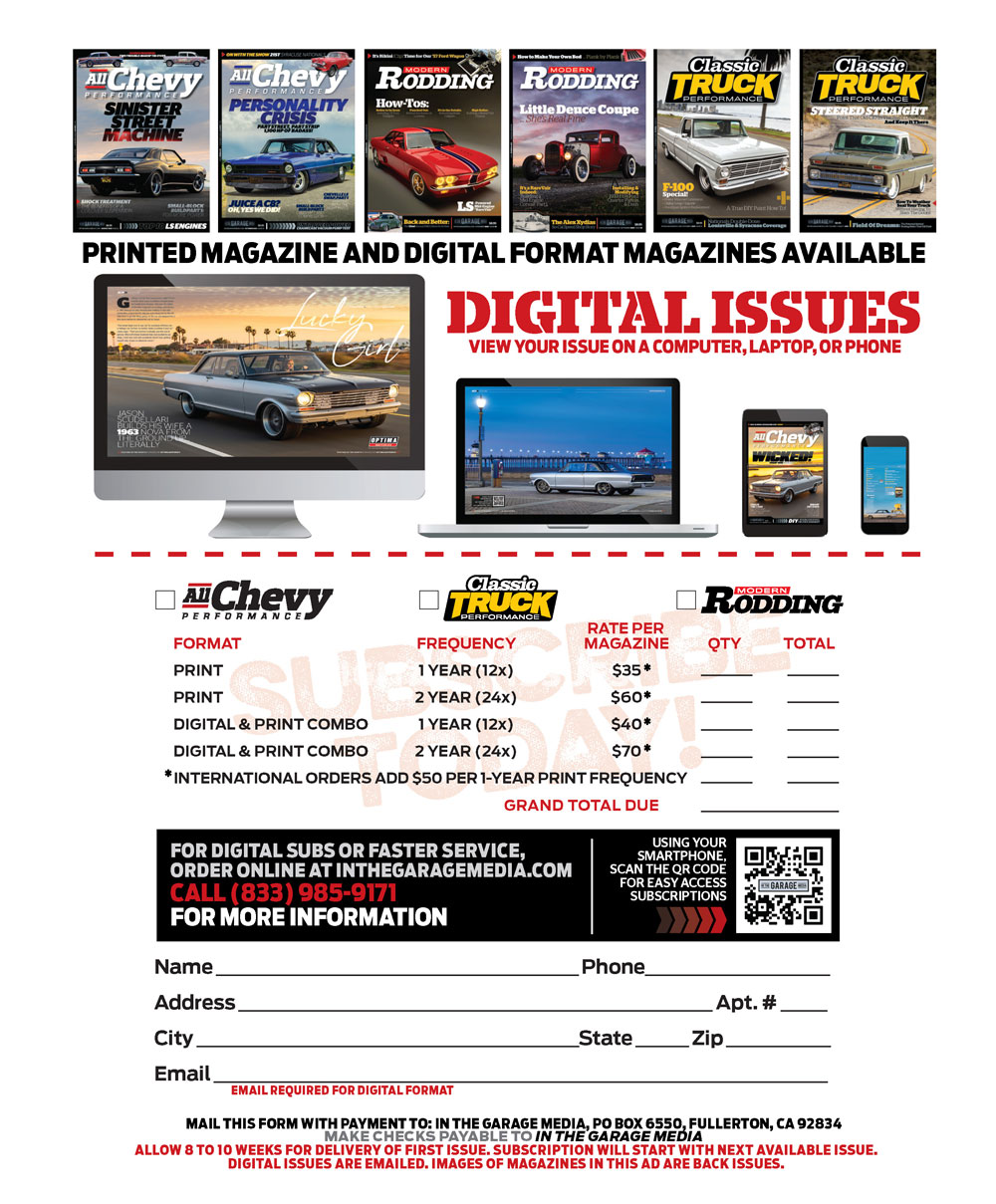 TOC
TOC
Photography by Randy Pugh.


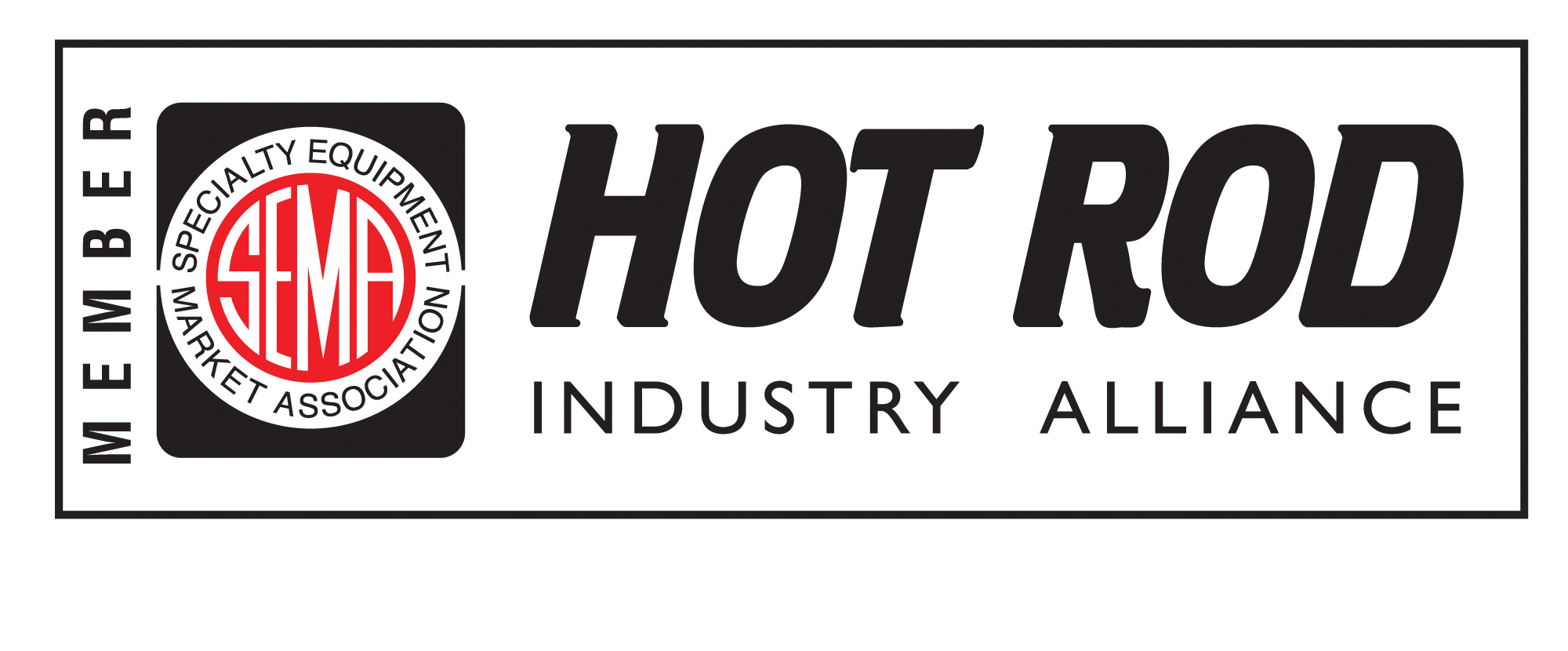

ROB MUNOZ
Wes Allison, Tommy Lee Byrd, Ron Ceridono, Grant Cox, Dominic Damato, Tavis Highlander, Jeff Huneycutt, Barry Kluczyk, Scotty Lachenauer, Jason Lubken, Steve Magnante, Ryan Manson, Jason Matthew, Josh Mishler, Evan Perkins, Richard Prince, Todd Ryden, Jason Scudellari, Jeff Smith, Tim Sutton, and Chuck Vranas – Writers and Photographers
AllChevyPerformance.com
ClassicTruckPerformance.com
ModernRodding.com
InTheGarageMedia.com
subscriptions@inthegaragemedia.com
Mark Dewey National Sales Manager
Patrick Walsh Sales Representative
Travis Weeks Sales Representative
ads@inthegaragemedia.com
inthegaragemedia.com “Online Store”
info@inthegaragemedia.com

Copyright (c) 2021 IN THE GARAGE MEDIA.
PRINTED IN U.S.A

 FIRING UP
FIRING UP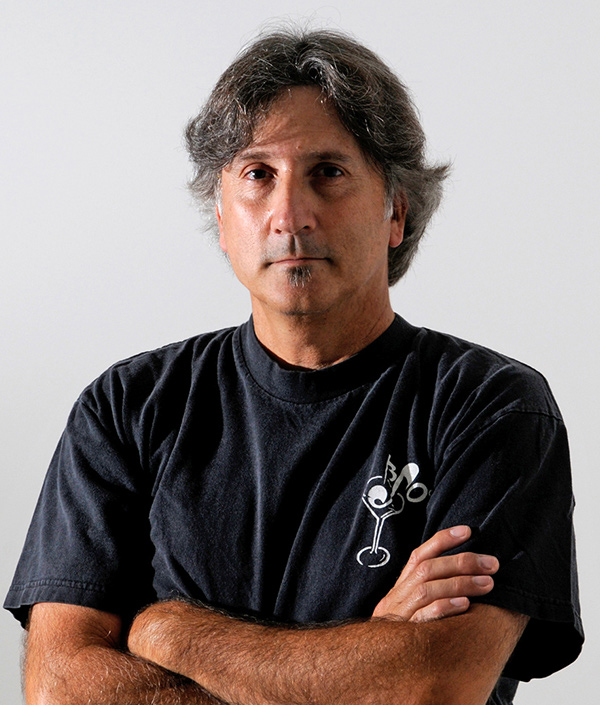
 BY NICK LICATA
BY NICK LICATA
t’s hard to believe, but this issue (Jan. ’22) marks the one-year anniversary of producing All Chevy Performance magazine. We started from scratch and began production in late 2020 and knew we had our work cut out. We were a small staff armed with big ideas, but we pulled it off. We were able to put together the baddest all-Chevy muscle car magazine in existence. But it wasn’t easy. In the beginning, we were firing on all eight cylinders, and like all fresh builds, there were some timing issues and we even fouled a few plugs along the way, but we didn’t give up. Today, we’re running on the rev limiter, and All Chevy Performance magazine looks as good if not better than we could have imagined.
Thanks to a brilliant group of photographers and knowledgeable technical writers, along with a talented art director (Rob, that’s you), and highly experienced in-house staff, I knew we would be able to put together a superior product. But even with all that experience we couldn’t have done it without you readers willing to take a chance and throw down some cash for a subscription to a brand-new, unproven magazine at a time when so many people wrote off print magazines as being “dead”–a sentiment we totally agree with. Print is dead when done the old way: printed on crappy paper with a small trim size and short on page count—all of which we could do better.
 Parts Bin
Parts Bin
InTheGarageMedia.com
 BY Nick Licata
BY Nick Licata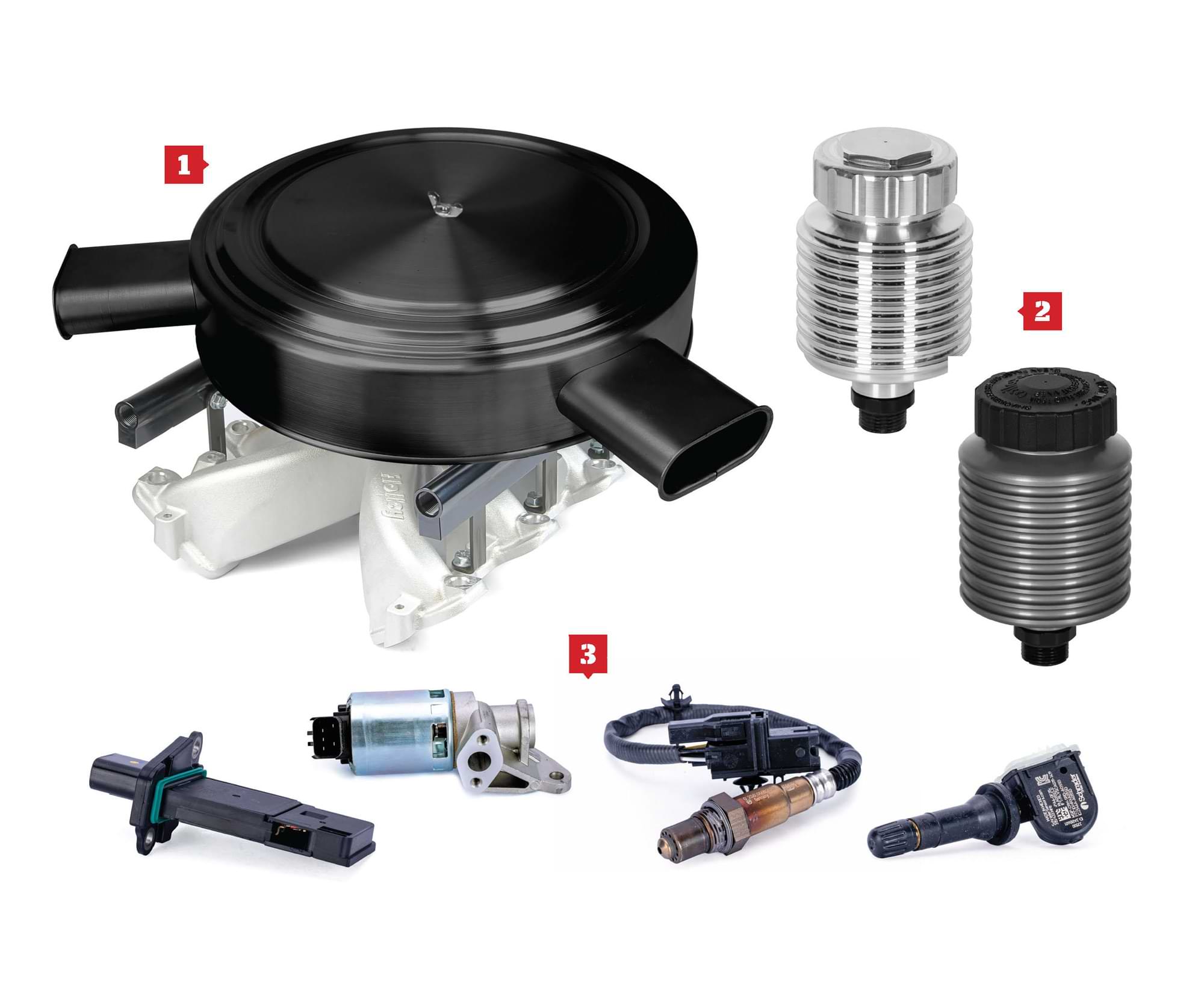

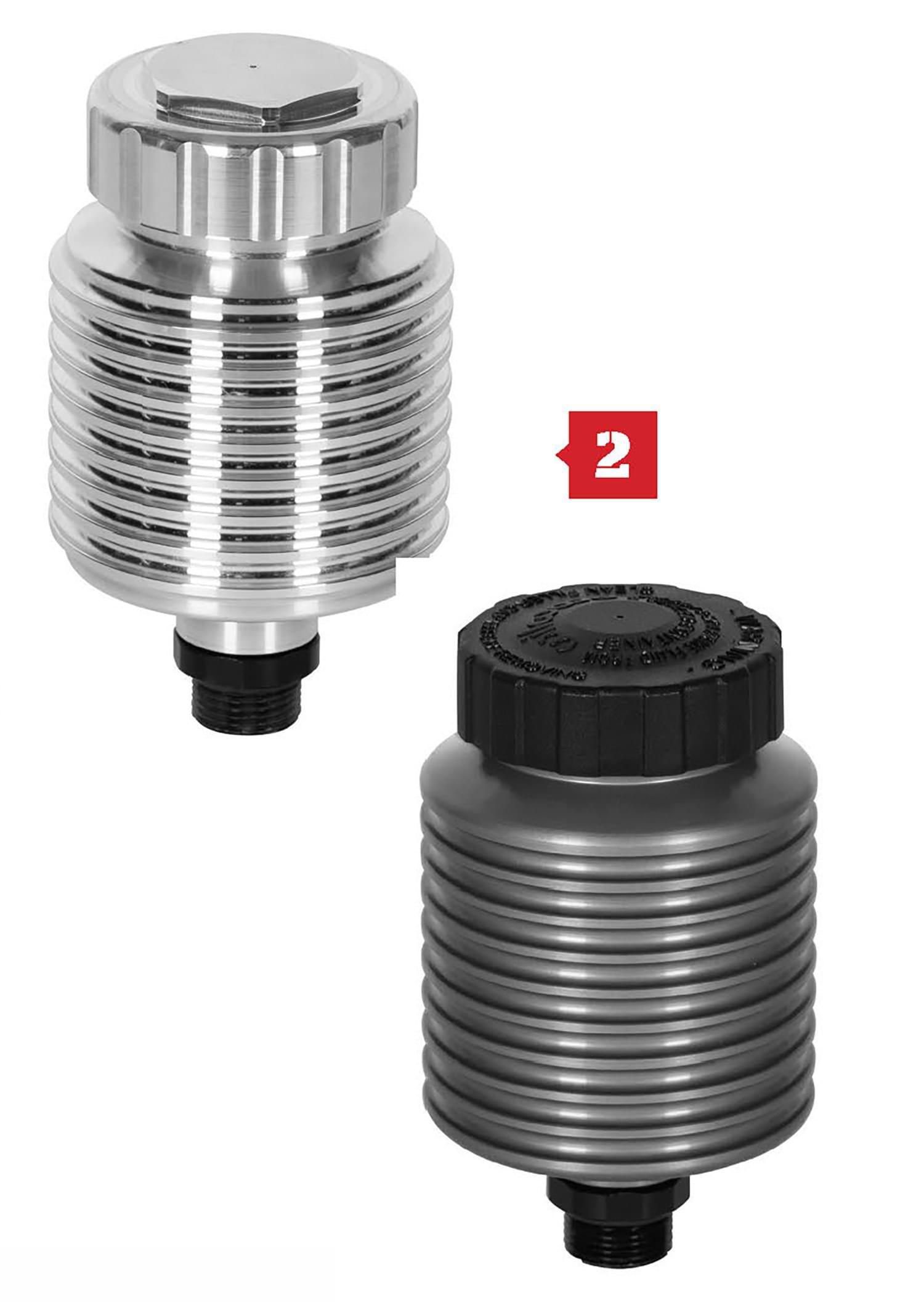

1. FAUX OH NINE
For more information, contact Lokar by calling (877) 469-7440 or visit lokar.com.
For more information, contact Willwood by calling (805) 338-1188 or visit wilwood.com.
With ’80s muscle cars showing up more in the hot rod world there are bound to be a few false readings from spent sensors causing issues with a stock fuel management system. Duralast offers vast number of drivetrain sensors, solenoids, and switches that provide a direct plug-in fit and are to OE specifications. From mass airflow to temperature sensors, crank, or cam position to knock sensors, Duralast has your engine management replacement sensors ready. Plus, every sensor is built to meet or exceed the OE design so each new sensor will function with the OEM (or aftermarket) fuel management system.
 CHEVY CONCEPTS
CHEVY CONCEPTS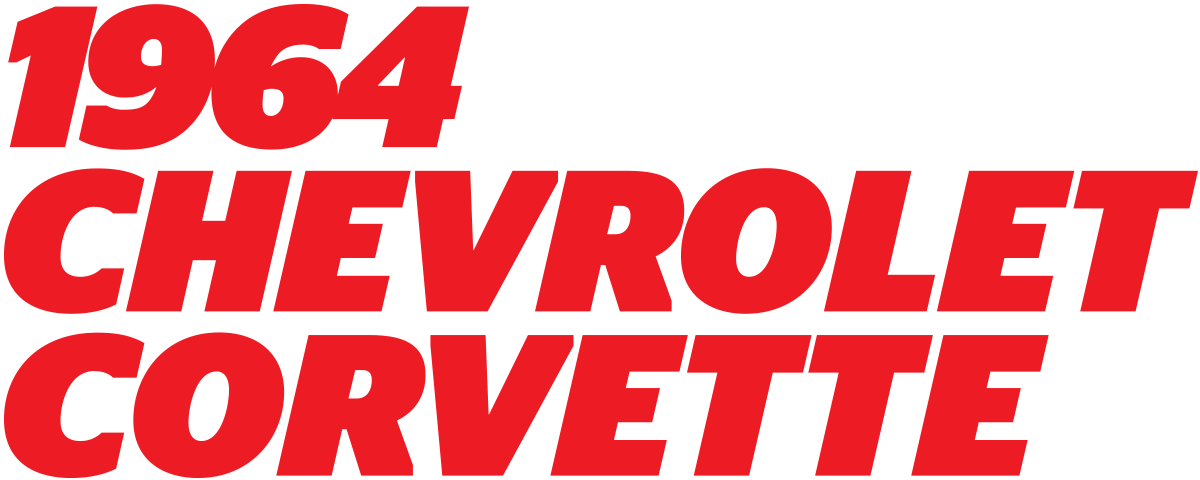
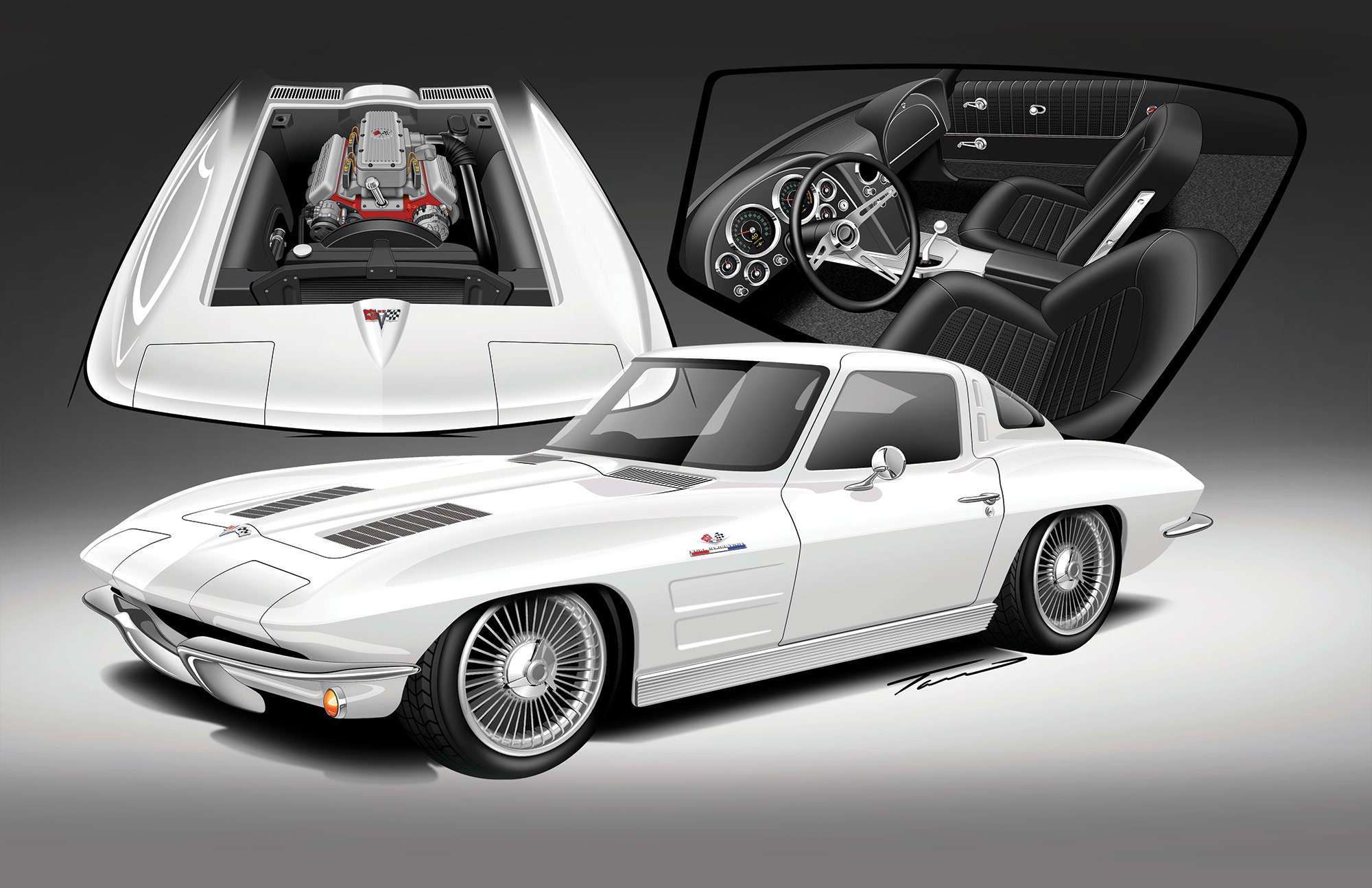
 Text and Rendering by Tavis Highlander
Text and Rendering by Tavis Highlander
ou’ve probably seen Cruzer’s Customs’ work via their recent ’64 Buick Riviera project called “Vanquish.” That car was a beautiful example of classic styling meeting modern performance in the right ratio. This new project looks to continue that theme within the fiberglass shell of a ’64 Corvette.
Billet turbine wheels allow for big brake clearance and also tip the hat to period-correct styling. Inside the cockpit will be stockish-appearing upholstery, but the craftsmanship will be brought up to a new level as will the materials. CNC-perforated leather will add a subtle bit of customization to the door panels and seats. Underhood is an LS with backdating accessories to make it look like a Rochester-injected fuelie. The combination of subtle mods add up to a dramatic end result, for sure.
 FEATURE
FEATURE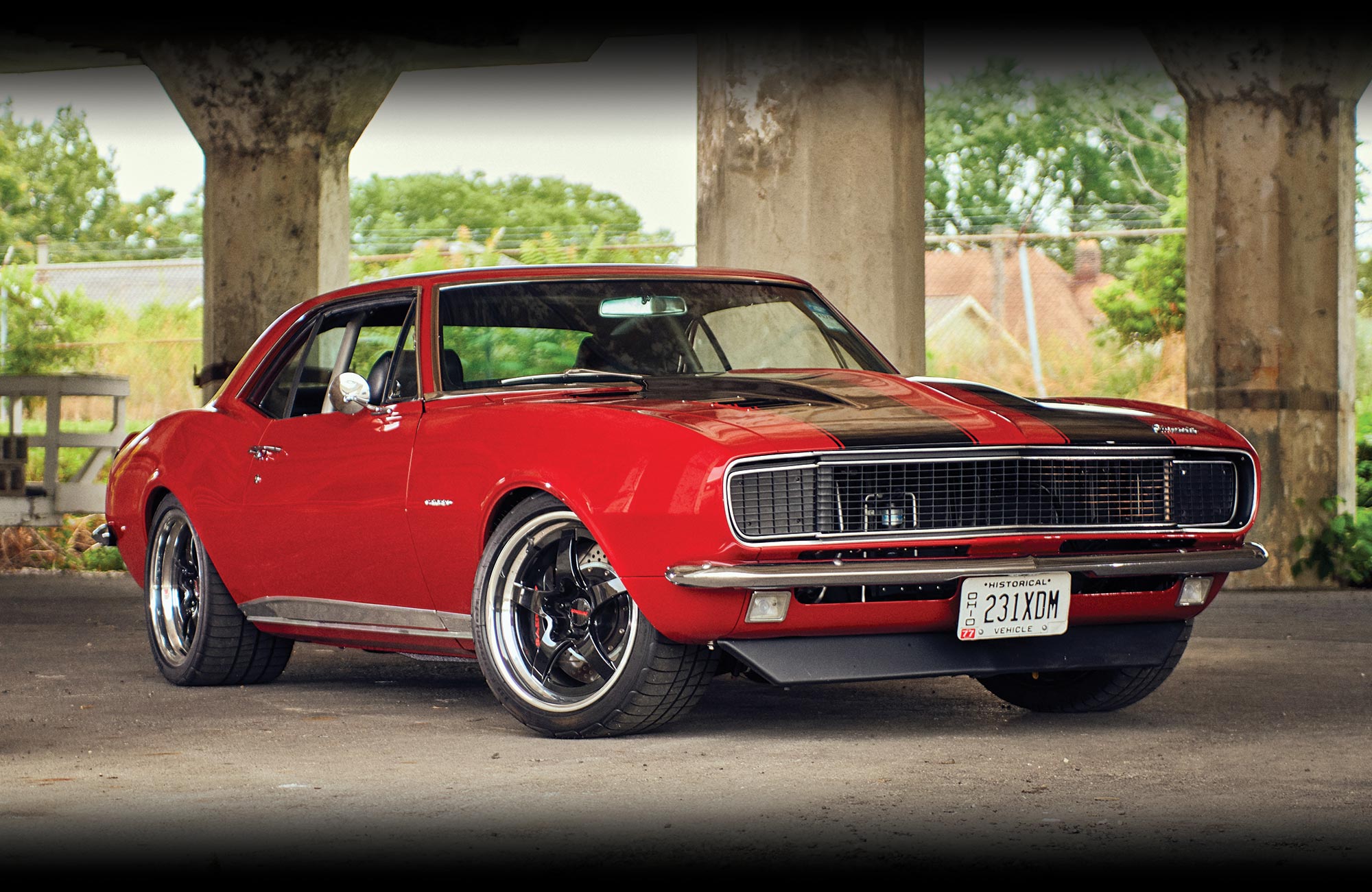


 Photography by Nick Licata
Photography by Nick Licata
 TECH
TECH Photography by NICK LICATA & Jason Scudellari
Photography by NICK LICATA & Jason Scudellari any, many years ago, well before editor Nick Licata got his first skateboard as a kid, one of the additions performance enthusiasts made to their cars was a row of aftermarket gauges hanging below the dashboard. Even though they were often difficult to see mounted near the floor, the general consensus was they were better than factory gauges, which were inaccurate at best and useless at worst. Most factory gauges didn’t react very quickly or have meaningful numbers, making them only slightly better than warning lights that would normally illuminate about the same time some sort of mechanical carnage was taking place. As proof we offer the instruments in our ’69 Chevrolet Camaro.
Apparently, when our base Camaro was new, the decision-makers at GM figured no one looks at gauges anyway, so we’ll save some money and go with just a speedometer, an extra-large gas gauge with warning lights for oil pressure, coolant temperature, and charging system status. (There were several gauge packages available that included such things as a tachometer, clock, oil pressure, temp gauge, and an ammeter, but they were extra-cost options.)
 FEATURE
FEATURE Photography by The Author
Photography by The Author
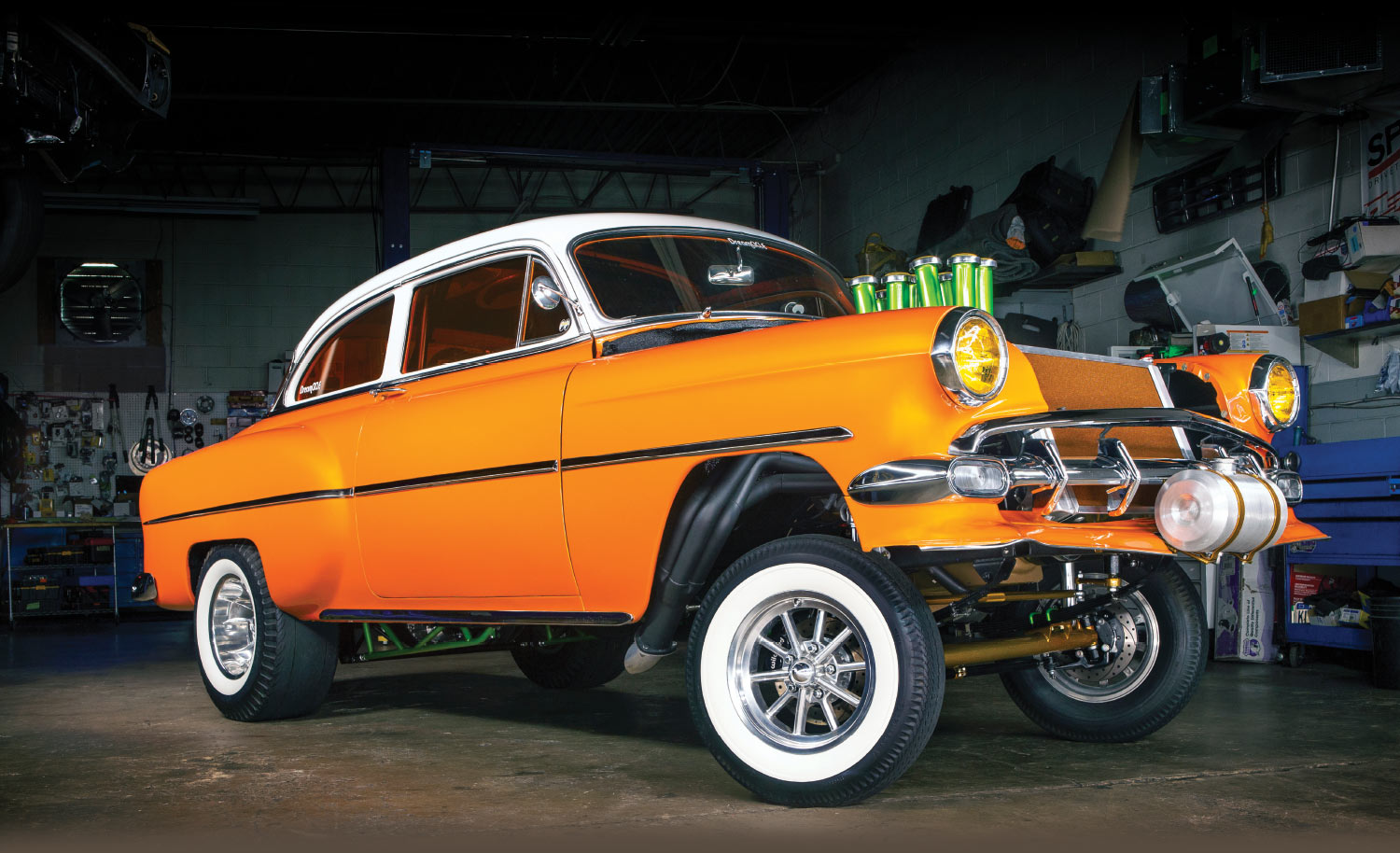
ne of the things about age is that it often forces us to reflect back and examine our past. Inevitably, we look at the mistakes and also the successes of life. When it comes to the automotive realm it’s often the one that shouldn’t have been sold, or the one we wanted but couldn’t afford. For Bob Fultano, his car rewind goes back to his teenage years. “I got my first car when I was 15,” he recalls. “It was a ’55 Chevy and over the years I’ve had numerous Chevelles and Novas–all big-block cars.” One taste that he acquired early on was for gassers, to the point that it eventually grew into a bucket list item. Fulfilling that desire came about back in 2019 when he started looking for one online. He stumbled across this ’54 Chevy a few states away in Maryland, which prompted a road trip. Shortly after, a box was checked off the bucket list. Bob ended up buying what appeared to be a complete gasser that was show-and-go ready–but in his eyes it was far from it. The paint, interior, and wheels all looked the part, but it had a lukewarm Chevy 350 small-block with aluminum heads, a mild cam, Holley 750 carb, all backed by a Turbo 350 automatic. He explains, “It could barely get out of its own way. For me, I kind of like to overdo things, and I’m really a big-block guy.”
 TECH
TECH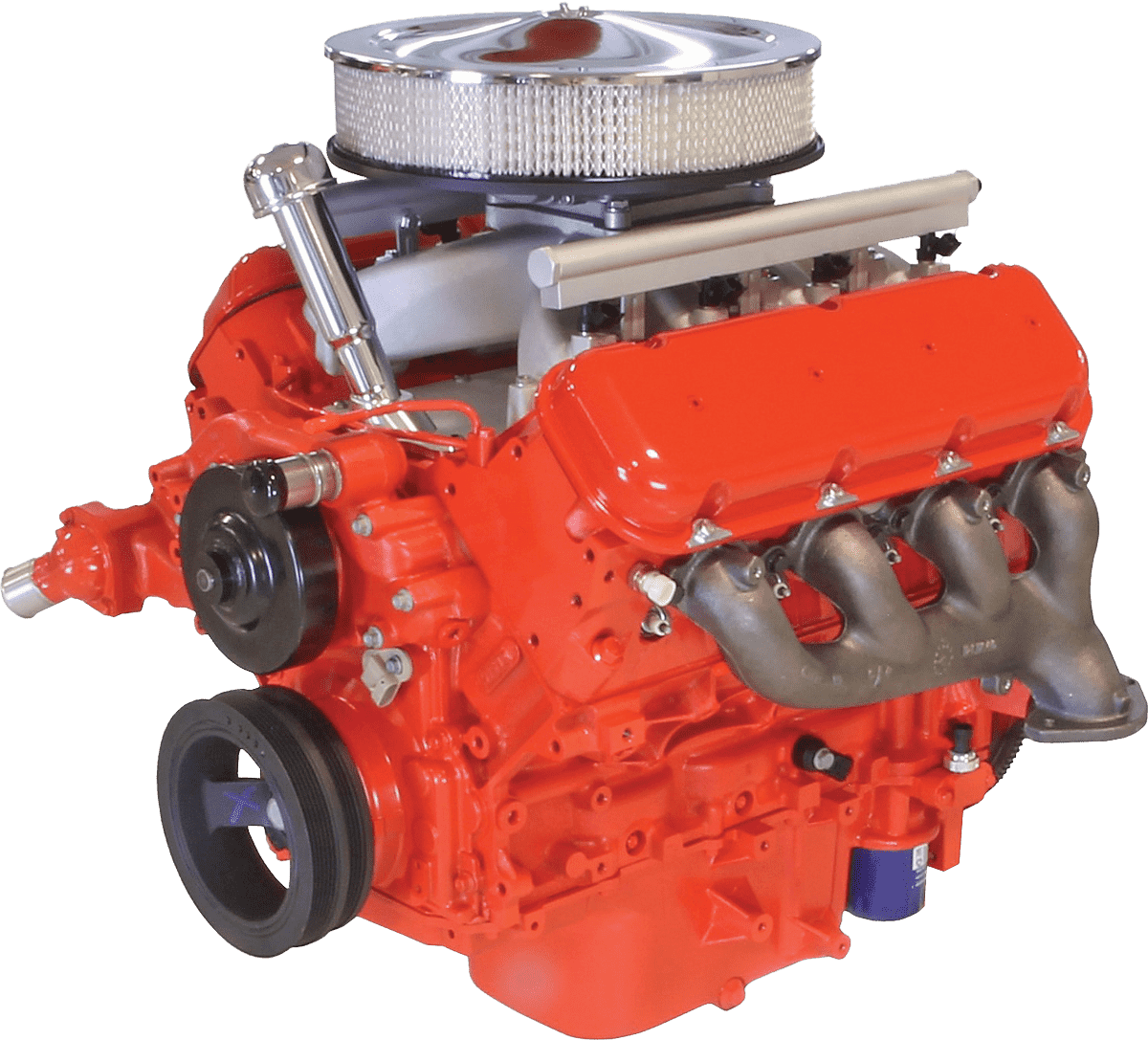

 Photography by the Author
Photography by the Authort’s not hard to argue the merits of the modern LS engine, especially those that show up in a wooden crate with everything inside needed to make ’em run. Turnkey, reliable powerplants using 21st century technology inside and out, capable of making gobs of power; what’s not to love? They work as advertised, there’s no arguing that, but when compared to their vintage brethren of years gone by, the modern LS engine falls flat. All that wiring, plastic, and drab gray aluminum leaves a lot to be desired in the looks department, especially when said powerplant finds itself between the inner fenders of a classic Chevy muscle car. The guys at LS Classic know this all too well and made it their credo to bring some vintage styling to the LS engine line.
As alluded, LS Classic Series by Lokar (their official name) offers a bunch of different components to help dress up that modern-looking LS engine, replacing that plastic with a little classic. From subtle things like cast-aluminum valve covers that mimic the stylings of the 409, small-, or big-block Chevy to entire induction systems that disguise the new as old, LS Classic has the solutions to bring your modern LS engine into the past. Their products are well thought out and designed to perform as good as they look. These aren’t cheesy dress-up parts that simply bolt in place and hide the components, oftentimes they incorporate the OE design, such as their use of original LS valve cover gaskets. Many of their induction systems use the original drive-by-wire throttle body and fuel injectors, making the installation compatible with GM and aftermarket ECUs. And if modifying a modern crate engine is beyond your comfort level, they even offer fully dressed crate engines that are ready to drop into that classic muscle car.
 FEATURE
FEATURE Photography by Jason Lubken
Photography by Jason Lubken

t seems the early Chevy Novas are in high demand these days, but the truth is many of them have been in the build process for a number of years. So, there is no denying their popularity, it’s just that they’ve been so for years. Good for us, as we are seeing the lengthy builds of these cool cars finally coming to fruition and hitting the streets.
Trent Young is one of those guys who has had his car “under the knife” for about 12 years. But let’s back up a bit–Trent found this ’66 Chevy II Nova in the Omaha World-Herald want ad section way back in 1992. The owner was asking $4,300 and it had some good stuff for the time: a rebuilt 283, Powerglide transmission, new brakes, exhaust, and some more updated pieces–Trent bit. “It needed paint and some interior work,” Trent says. “As I was stripping the paint I soon found out it needed a lot more bodywork than I had originally thought, and the floorpans were rusted out as well.”
Trent developed a foundation for car building at a very young age while watching his dad, Jim, wrench on and buy and sell hot rods. He started out fetching tools and holding the light for his dad, and by the time he was 16 he did general car maintenance and some upgrades on his own as well. Like his pops, he began buying and selling a few cars here and there for some side cash.
So with the knowledge he absorbed, Trent tore the Nova down and basically started from scratch. Not exactly what he had in mind when he bought the car, but it was now in full-on restoration mode.
 TECH
TECH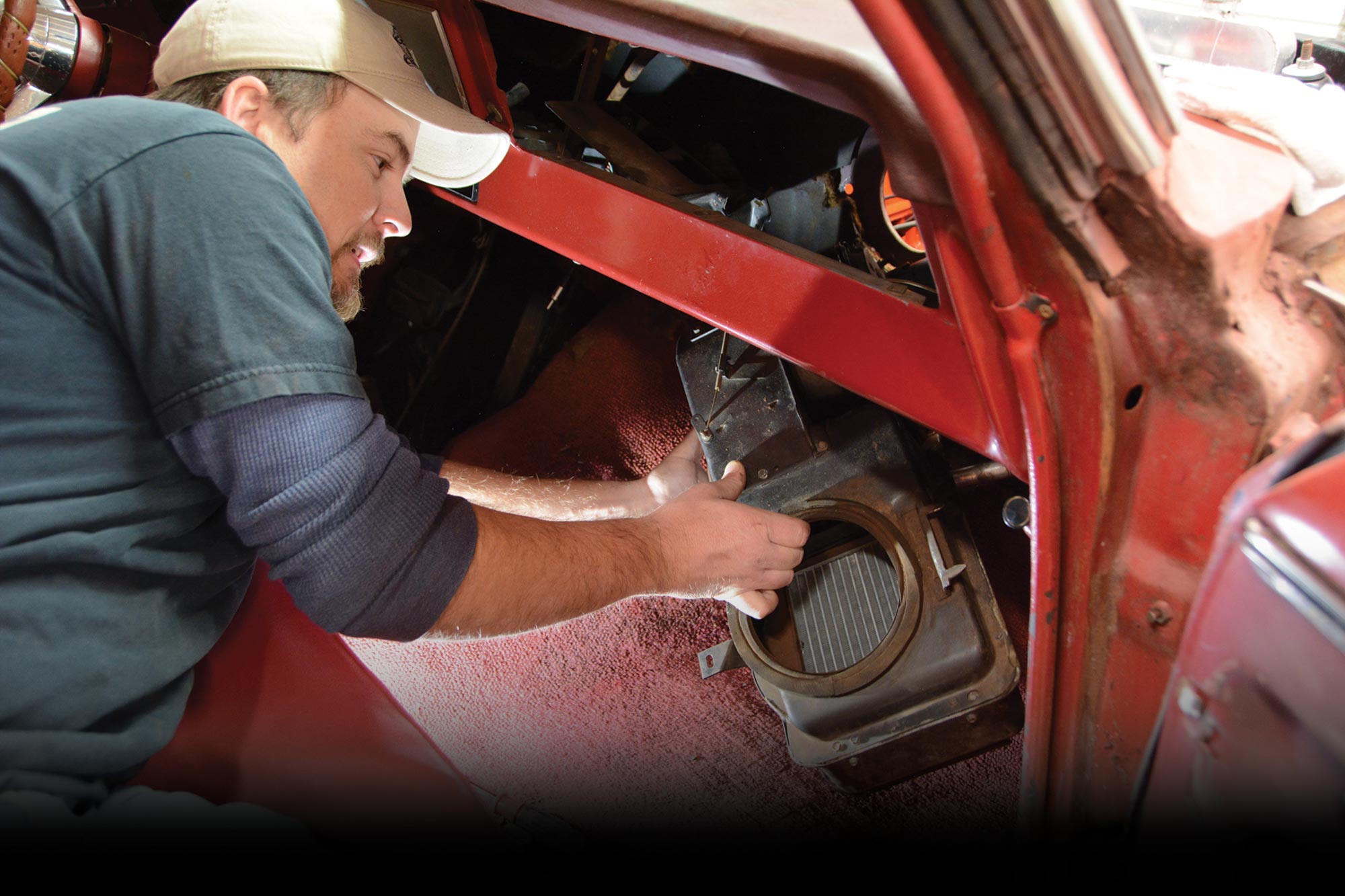
Climate Change
 Photography by The Author
Photography by The Authorhange is always a little intimidating, especially when something has been unchanged for 55 years. This ’66 Chevy II has spent most of its years in completely original condition and still has its 194ci six-cylinder engine and Powerglide automatic transmission. Typically, a six-cylinder Chevy II would’ve made an easy candidate for a hot rod, but somehow this one survived. While an LS swap would be a simple transition in the modern sense, we’re embracing the original powertrain. We do have plans to upgrade this car in an effort to make it more comfortable and reliable for road trips. The first step in that process is air conditioning, so we called up the folks at Vintage Air for some guidance.
Our original question was in regard to the engine and how we would adapt a Vintage Air kit to the inline-six. As it turns out, Vintage Air makes an exact bracket for the engine, which made for an easy decision. We ordered a Vintage Air SureFit kit (PN 961166), which fits ’66 and ’67 Chevy II/Novas and added the Steel-eez compressor bracket (PN 146037) for direct fitment on the inline six-cylinder. It also fits 230- and 250ci Chevy inline-six engines. We also added Vintage Air’s new Control Panel (PN 473272), which fits in the factory location and makes it completely electronic. The final item on our order was an E-Z Clip hose system (PN 547002), which means that we can easily build our own refrigerant hoses and crimp them in our own shop.
To install this kit on your Chevy II, you’ll need an assortment of hand tools as well as a cut-off wheel and a step drill bit (or a 11/4-inch hole saw bit). Since this installation involves quite a bit of shop time, we split this into two parts. In this article, we’ll cover the Steel-eez brackets, condenser, hard lines, and drier installation. We also begin disassembling the interior components in preparation for the new Vintage Air evaporator. Next month, we’ll wrap it up and have our six-cylinder Chevy II back in action—except now it will be climate controlled and one step closer to enjoying road trips, no matter the weather.
 FEATURE
FEATURE

 BY Tommy Lee Byrd
BY Tommy Lee Byrd Photography BY The Author
Photography BY The Authorhe muscle car era is a time that car enthusiasts believe to be the heyday of horsepower. Even though we understand that today’s horsepower and technology surpass anything that Detroit built during the ’60s, we also know that today’s cars lack the visceral feeling you get from a real-deal, old-school muscle car. For Jimmy Arnold of Church Hill, Tennessee, no amount of technology can replace that feeling. He grew up during the tail end of the muscle car era and distinctly remembers his uncle having a ’67 Chevelle with Cragar wheels and popular bolt-on modifications from the era. That car made an impact on his taste in cars, and it led him to own a few Chevelles of his own, including the incredible Day Two creation on these pages.
 TECH
TECH Photography by Jason Scudellari
Photography by Jason Scudellarior most of us the prospect of wiring a car ranks right up there with going to the dentist for a root canal—in both cases a certain amount of worry results from anticipating the uncomfortable procedure about to take place. While we can’t do much about visiting the dentist, we can advise the easy way to wire your pride and joy, and that’s with a wiring system from American Autowire. To install it you don’t have to know any more about electricity than that it’s the stuff that makes the engine run when you turn the key and the lights come on when you pull on the switch.
There are a variety of reasons for rewiring an older car, and in many cases time has taken its toll on the original electrical system to the point that safety and reliability become issues. Over the years, wires and connections will deteriorate, and it’s not unusual for ill-advised and poorly executed modifications to have been made. But more often than not updates are needed to add electrical accessories that the vehicle was never equipped with. To address all those issues, American Autowire offers three types of wiring solutions:
 TECH
TECHBY Ron Ceridono  Photography by Jason Scudellari
Photography by Jason Scudellari
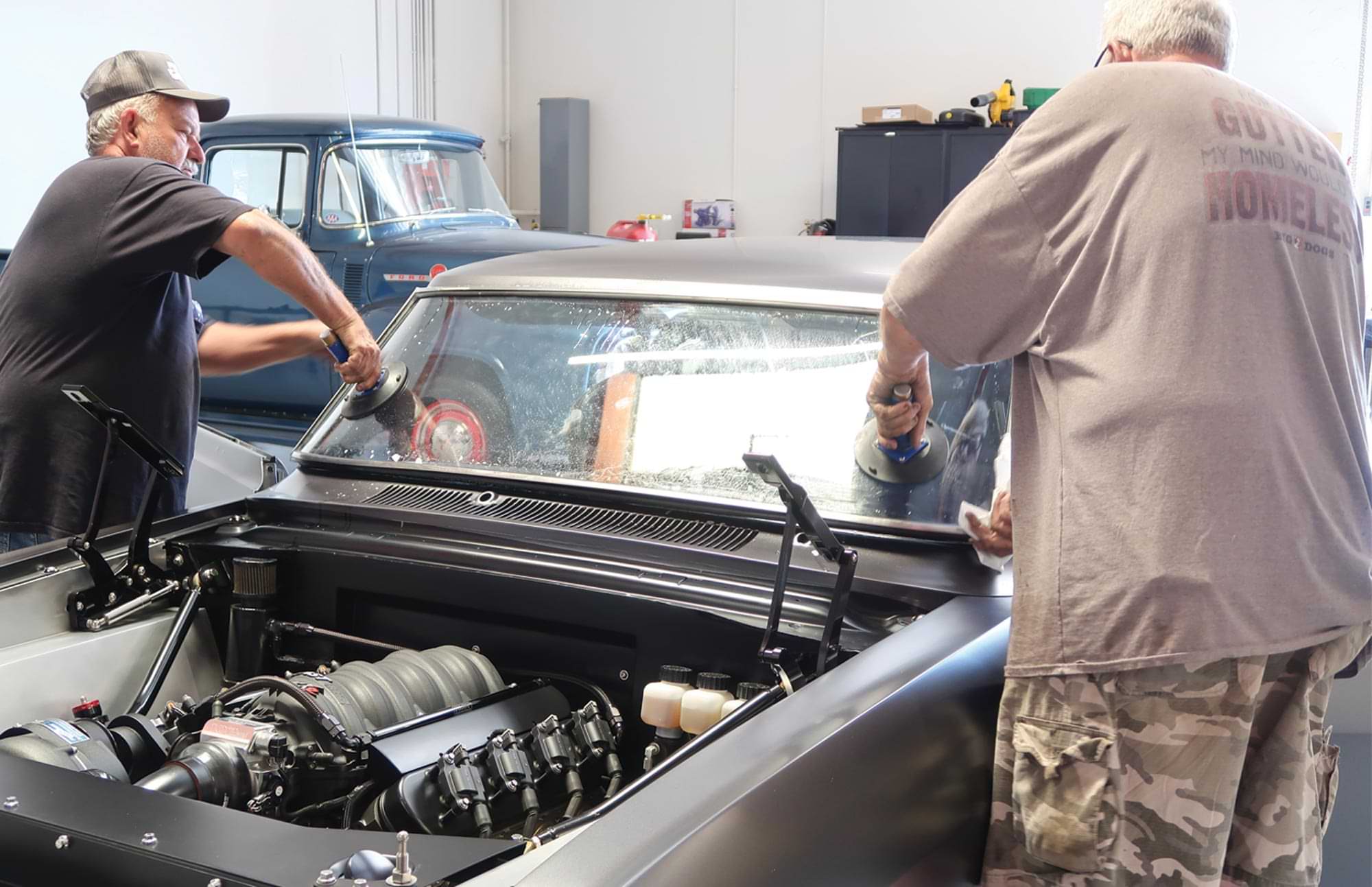
See-Through Chevy
here are many reasons for replacing a vehicle’s glass. It may be broken, blasted by the elements, making it hard to see through, and, of course, there may be scratches in the windshield that look like wipers ran for months without a rubber blade. Then for project cars like Randi Scudellari’s ’63 Chevy Nova, removing all the glass, associated rubber gaskets, and trim is part of doing a primo paintjob; it’s the best way to refinish all those hard-to-reach areas around the window openings.
While all automotive glass looks the same, there are significant differences. Windshields are made of laminated glass, which is constructed by sandwiching a thin layer of polyvinyl butyral (PVB) between two layers of glass. The combination is then heated and pressed together, with the end result being glass that doesn’t shatter when broken as the middle layer holds it together.
Over the years the process of laminating glass has been refined. At one time it wasn’t uncommon for the edges of older laminated glass to become foggy due to the layers separating. Today materials and processes have improved, eliminating that problem. Another development was tinted glass. Windshields are often tinted a blue or blue-green color by adding iron oxide to the glass during manufacture, or putting a dye in the inner liner to create a darker band of color at the top of the glass.
 EVENT
EVENT
 Photography BY The Author
Photography BY The Authort’s been 27 years since Dan Jensen, Dennis Jensen, Lyndon Hughes, and a few other loyalists banded together to pull vintage muscle cars off the show field and shove them down the dragstrip. The Pure Stock Muscle Car Drag Race (PSMCDR) quickly grew into a must-attend event for owners and enthusiasts across the U.S. and Canada—a throwback kaleidoscope of color, horsepower, and tire smoke.
“The goal from the very beginning was to give owners a place to enjoy their cars the way they were always intended,” Dan Jensen says, who also notes his trio gets about four hours of sleep for the entire month of September, as they and a few volunteers organize and stage the event at Mid-Michigan Motorplex, a rural dragstrip surrounded by lush farmland on all sides.
Advertiser
- ACES Fuel Injection85
- Aldan American75
- American Autowire61
- Art Morrison Enterprises25
- Auto Metal Direct7
- Auto Revolution Online85
- Automotive Racing Products37
- Borgeson Universal Co.57
- Bowler Performance Transmissions85
- Classic Industries53
- Classic Instruments71
- Classic Performance Products4-5, 83, 92
- Concept One Pulley Systems83
- Custom Autosound23
- Dakota Digital91
- Danchuk USA11
- Duralast26-27
- Eddie Motorsports63
- FiTech EFI19
- Flaming River Industries39
- Gandrud Chevrolet85
- Granatelli Motor Sports79
- Heidts Suspension Systems69
- HushMat87
- John’s Industries83
- Lokar2
- National Street Rod Association67
- Original Parts Group9
- Powermaster Performance71
- Schwartz Performance87
- Scott’s Hotrods79
- Speedway Motors55
- Steele Rubber Products43
- Strange Engineering75
- That’s Great News87
- Thermo-Tec Automotive83
- Vintage Air6
- Wilwood Engineering41
 BOWTIE BONEYARD
BOWTIE BONEYARD Photography by the Author
Photography by the Author
t’s time once again to venture forth into the Bowtie Boneyard. Here, we visited Bernardston Auto Wrecking (413-648-9300) in Bernardston, Massachusetts, where proprietor Dale Hastings runs a quiet but successful operation amid the pine trees and wild bears of the New England forest.
Our review was marked by a large number of manual transmission–equipped Chevys, just a few of which are presented here. Manual transmissions increase the connection between driver and car and also generally increase the fun factor. Let’s dig in …





